Advertisement

How Cruise Control Systems Work
- Share Content on Facebook
- Share Content on LinkedIn
- Share Content on Flipboard
- Share Content on Reddit
- Share Content via Email
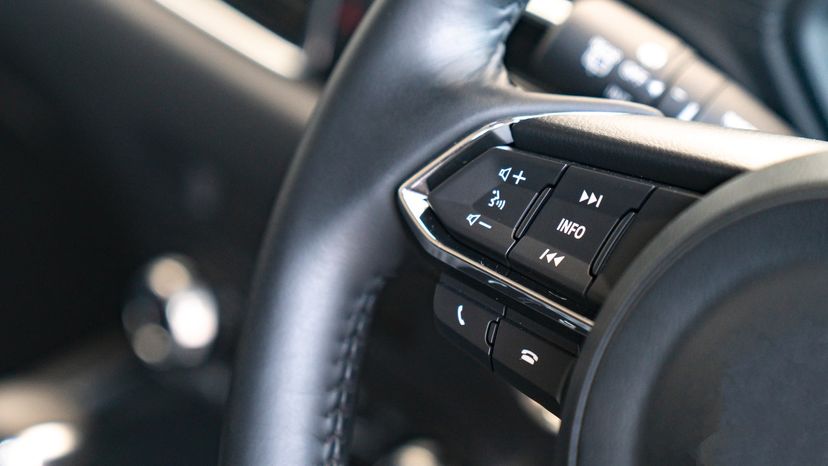
Cruise control is an invaluable feature on American cars. Without cruise control, long road trips would be more tiring, for the driver at least, and those of us suffering from lead-foot syndrome would probably get a lot more speeding tickets.
Cruise control is far more common on American cars than European cars, because the roads in America are generally bigger and straighter, and destinations are farther apart. With traffic continually increasing, basic cruise control is becoming less useful, but instead of becoming obsolete, cruise control systems are adapting to this new reality -- soon, cars will be equipped with adaptive cruise control, which will allow your car to follow the car in front of it while continually adjusting speed to maintain a safe distance.
In this article, we'll learn how a conventional cruise control system works, and then we'll take a look at adaptive cruise control systems that are under development.
What Cruise Control Does
Cruise control acceleration and deceleration, controlling the cruise control, adaptive cruise control.
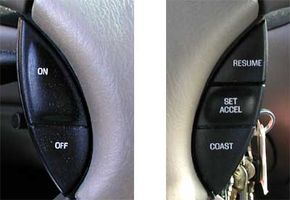
The cruise control system actually has a lot of functions other than controlling the speed of your car. For instance, the cruise control pictured below can accelerate or decelerate the car by 1 mph with the tap of a button. Hit the button five times to go 5 mph faster. There are also several important safety features -- the cruise control will disengage as soon as you hit the brake pedal, and it won't engage at speeds less than 25 mph (40 kph).
The system pictured below has five buttons: On, Off, Set/Accel, Resume and Coast. It also has a sixth control -- the brake pedal, and if your car has a manual transmission the clutch pedal is also hooked up to the cruise control.
- The on and off buttons don't actually do much. Hitting the on button does not do anything except tell the car that you might be hitting another button soon. The off button turns the cruise control off even if it is engaged. Some cruise controls don't have these buttons; instead, they turn off when the driver hits the brakes, and turn on when the driver hits the set button.
- The set/accel button tells the car to maintain the speed you are currently driving. If you hit the set button at 45 mph, the car will maintain your speed at 45 mph. Holding down the set/accel button will make the car accelerate; and on this car, tapping it once will make the car go 1 mph faster.
- If you recently disengaged the cruise control by hitting the brake pedal, hitting the resume button will command the car to accelerate back to the most recent speed setting.
- Holding down the coast button will cause the car to decelerate, just as if you took your foot completely off the gas. On this car, tapping the coast button once will cause the car to slow down by 1 mph.
- The brake pedal and clutch pedal each have a switch that disengages the cruise control as soon as the pedal is pressed, so you can shut off the cruise control with a light tap on the brake or clutch.
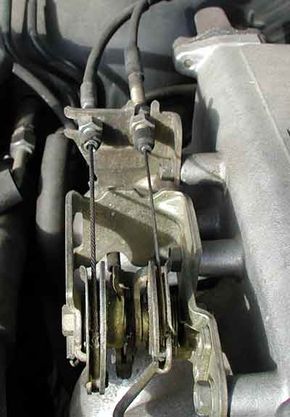
The cruise control system controls the speed of your car the same way you do -- by adjusting the throttle position . But cruise control actuates the throttle valve by a cable connected to an actuator , instead of by pressing a pedal. The throttle valve controls the power and speed of the engine by limiting how much air the engine takes in (see How Fuel Injection Systems Work for more details).
In the picture above, you can see two cables connected to a pivot that moves the throttle valve. One cable comes from the accelerator pedal, and one from the actuator. When the cruise control is engaged, the actuator moves the cable connected to the pivot, which adjusts the throttle; but it also pulls on the cable that is connected to the gas pedal -- this is why your pedal moves up and down when the cruise control is engaged.
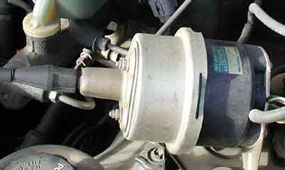
Many cars use actuators powered by engine vacuum to open and close the throttle. These systems use a small, electronically-controlled valve to regulate the vacuum in a diaphragm. This works in a similar way to the brake booster , which provides power to your brake system.
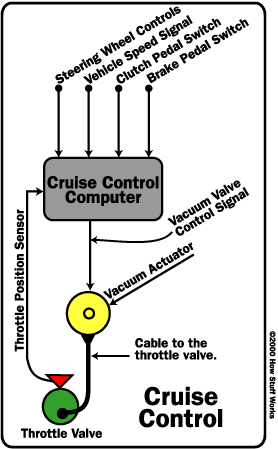
The brain of a cruise control system is a small computer that is normally found under the hood or behind the dashboard. It connects to the throttle control seen in the previous section, as well as several sensors. The diagram below shows the inputs and outputs of a typical cruise control system.
A good cruise control system accelerates aggressively to the desired speed without overshooting, and then maintains that speed with little deviation no matter how much weight is in the car, or how steep the hill you drive up. Controlling the speed of a car is a classic application of control system theory . The cruise control system controls the speed of the car by adjusting the throttle position, so it needs sensors to tell it the speed and throttle position. It also needs to monitor the controls so it can tell what the desired speed is and when to disengage.
The most important input is the speed signal; the cruise control system does a lot with this signal. First, let's start with one of the most basic control systems you could have -- a proportional control .
In a proportional control system, the cruise control adjusts the throttle proportional to the error, the error being the difference between the desired speed and the actual speed. So, if the cruise control is set at 60 mph and the car is going 50 mph, the throttle position will be open quite far. When the car is going 55 mph, the throttle position opening will be only half of what it was before. The result is that the closer the car gets to the desired speed, the slower it accelerates. Also, if you were on a steep enough hill, the car might not accelerate at all.
Most cruise control systems use a control scheme called proportional-integral-derivative control (a.k.a. PID control). Don't worry, you don't need to know any calculus to make it through this explanation -- just remember that:
- The integral of speed is distance.
- The derivative of speed is acceleration.
A PID control system uses these three factors -- proportional, integral and derivative, calculating each individually and adding them to get the throttle position.
We've already discussed the proportional factor. The integral factor is based on the time integral of the vehicle speed error . Translation: the difference between the distance your car actually traveled and the distance it would have traveled if it were going at the desired speed, calculated over a set period of time. This factor helps the car deal with hills, and also helps it settle into the correct speed and stay there. Let's say your car starts to go up a hill and slows down. The proportional control increases the throttle a little, but you may still slow down. After a little while, the integral control will start to increase the throttle, opening it more and more, because the longer the car maintains a speed slower than the desired speed, the larger the distance error gets.
Now let's add in the final factor, the derivative . Remember that the derivative of speed is acceleration. This factor helps the cruise control respond quickly to changes, such as hills. If the car starts to slow down, the cruise control can see this acceleration (slowing down and speeding up are both acceleration) before the speed can actually change much, and respond by increasing the throttle position.
Two companies are developing a more advanced cruise control that can automatically adjust a car's speed to maintain a safe following distance. This new technology, called adaptive cruise control , uses forward-looking radar , installed behind the grill of a vehicle, to detect the speed and distance of the vehicle ahead of it.
Adaptive cruise control is similar to conventional cruise control in that it maintains the vehicle's pre-set speed. However, unlike conventional cruise control, this new system can automatically adjust speed in order to maintain a proper distance between vehicles in the same lane. This is achieved through a radar headway sensor , digital signal processor and longitudinal controller . If the lead vehicle slows down, or if another object is detected, the system sends a signal to the engine or braking system to decelerate. Then, when the road is clear, the system will re-accelerate the vehicle back to the set speed.
The 77-GHz Autocruise radar system made by TRW has a forward-looking range of up to 492 feet (150 meters), and operates at vehicle speeds ranging from 18.6 miles per hour (30 kph) to 111 mph (180 kph). Delphi's 76-GHz system can also detect objects as far away as 492 feet, and operates at speeds as low as 20 mph (32 kph).
Adaptive cruise control is just a preview of the technology being developed by both companies. These systems are being enhanced to include collision warning capabilities that will warn drivers through visual and/or audio signals that a collision is imminent and that braking or evasive steering is needed.
For more information on cruise control, check out the links below.
Cruise Control FAQ
How does cruise control work, how does adaptive cruise control work, will adaptive cruise control stop the vehicle, when would you use cruise control, how useful is cruise control, lots more information, related articles.
- How Car Engines Work
- How Brakes Work
- How Manual Transmissions Work
- How Fuel Injection Systems Work
- How Radar Detectors Work
- Ignition System Quiz
More Great Links
- BMW: Cruise-control-equipped motorcycle
- Cruise Control Block Diagram
- Cruise Control Installers' Instructions
- Cruise Control Service Tips
Please copy/paste the following text to properly cite this HowStuffWorks.com article:
How Does Cruise Control Work?
Cruise control is awesome, be it regular or adaptive cruise. But, how does cruise control work, and can you trust it while driving?
We invented cars as means of transportation, to go faster and to go further. But the evolution of cars didn't stop there. Comfort has become a necessity, leading to the invention of features purely for driver convenience—features such as cruise control.
Cruise control lets you take your foot off the gas pedal without your car losing speed. With cruise control, you enter the speed, and then the car keeps cruising at that speed.
It's bliss for driving long distances on highways, but how does cruise control actually work?
What Is Cruise Control?
Cruise control is a driving assist that maintains a constant driving speed without your foot on the gas pedal. Cruise control has been around for a long time, but only in the past few years has it become more common in economy cars.
There are various types of cruise control mechanisms, and these usually work according to the type of throttle system in your car. However, some manufacturers take this feature to the next level with adaptive cruise control, automatically altering cruise speed.
Cruise control has evolved many times since it was first used in automobiles. As mentioned before, cruise control's working mechanism revolves around the throttle system. Right now, there are mostly two types of throttle systems in the cars you see out in the streets: the older cable throttle and the newer drive-by-wire throttle.
Cruise Control in Older Cars with Cable Throttle
Cable throttle systems use mechanical connections, and thus, the cruise control on these cars works mechanically as well.
In cars with cable throttle systems, the cruise control actuator is connected to the throttle body through a cable on one side. On the other side, the actuator is connected to a pump.
Most cruise control actuators in cable throttle bodies use a set of springs and rely on vacuum pressure. The pump connected to the actuator creates a vacuum that tightens the springs in the actuator and this, in turn, puts tension on the cable. This cable is connected to the throttle body, and when the actuator puts tension on the cable, the throttle body opens in response. This ultimately gives your car gas without the gas pedal being used.
Related: What Is an Immobilizer and Does My Car Have One?
Now remains the question of how a specific speed is set for the actuator. This all goes through the car's electronic control unit or ECU. You press a button in your car to activate cruise control, and the ECU powers the pump in just the right amount to put the right tension on the cable. Lo and behold your car drives without your foot on the gas pedal!
The ECU also takes info from the speed sensor to see if the current speed and the target speed match. If your car is going faster than it should, then the ECU will release some tension on the cable, and if it's going slower, it will increase the tension.
Some cars use valves instead of pumps to create the vacuum in the cruise control actuator. In that case, the ECU is responsible for opening and closing that valve.
Keep in mind that there are various types of cruise control actuators, and not all use springs, though most do.
Cruise Control in Newer Cars with Drive-By-Wire Throttle
The cruise control system in newer cars with drive-by-wire throttle bodies is entirely electronic. Since there are no mechanical parts involved, the ECU gets the current speed and decreases or increases it to reach the target speed.
In these cars, the ECU talks directly to the electronic control module (ECM). The ECM is responsible for controlling the throttle body to accelerate or decelerate. Once you set your preferred speed, the ECU grabs that and sorts it out with the ECM and just like that, your car drives at your preferred speed.
How Does Adaptive Cruise Control Work?
Adaptive cruise control (ACC) is an advanced form of cruise control that takes in information from sensors other than the speed sensor to determine the ideal speed in real-time.
ACC talks to proximity sensors such as radar and lidar, speed sensors, and a combination of cameras to take in the other vehicles on the road and the road itself. Once the signals are received and processed, ACC determines the safe distance and speed.
This system then alters the speed accordingly, reducing your car's speed if you're getting too close to another car in front or if you're nearing a turn. Once the road is clear, ACC accelerates the car to the target speed you have set.
In some cars, ACC can even trigger the brake systems to decelerate the car quickly in case the car in front suddenly brakes or a hazard appears.
Related: How Does Adaptive High Beam Assistance Work?
Cruise Control in Motorcycles
Unlike cars, motorcycles don't have gas pedals. They have gas handles instead. Unfortunately, holding a gas handle for a long duration is much more frustrating than holding a gas pedal. This nuisance has called for a technology similar to cruise control in function but different in design: throttle lock.
Throttle lock functions similarly to cruise control in cable throttle cars, except it skips the actuator and the ECU and directly deals with the throttle body.
Throttle lock works by locking the throttle cable and maintaining a constant amount of tension on the cable. This keeps the motorcycle cruising at a steady speed.
The simplicity of the throttle lock has a catch. Throttle lock doesn't check in with the speed sensors to see if it's going any faster or slower than the target speed, so it only works well on flat roads.
When to Use (and Not to Use!) Cruise Control
Use cruise control on straight roads with little traffic. As a safety measure, braking will disengage cruise control, and on a road with lots of vehicles, you'll need to brake often.
Cars naturally decelerate when you take your foot off the gas pedal, but that won't be the case when you have cruise control activated. It might be too late by the time you hit the brakes when you use cruise control on a crowded road.
This also goes for roads with lots of turns and twists. Entering a sharp turn with high speed is often dangerous. Put the turns behind you and once you have a straight road, engage the cruise control.
Though the point of cruise control is to make your ride more comfortable, it's prone to make you a bit too comfortable. Falling asleep behind the wheels with cruise control engaged is likelier to happen. Albeit this time, the car won't decelerate and will keep going.
Related: Standalone vs. Integrated Car Navigation Systems: What's the Best Option?
Adaptive cruise control solves most of the limitations that come with ordinary cruise control systems, but it still isn't flawless. Adaptive cruise control relies on your car's sensors to decide the appropriate speed, and these sensors can get blocked in bad weather. Snow, mud, rain, and other natural hazards can get in the way of your car's sensors and make the adaptive cruise control less reliable.
Adaptive cruise control has limited access to the braking system, and it won't be able to stop a head-on collision. Use the brakes yourself and remember that cruise control is only a driver assist feature, not an autopiloting system.
With this in mind, please take full control of your vehicle in bad weather and tricky roads. Don't trust the cruise control, be it normal or adaptive.
Cruising with Control
The cruise control system was first strictly found on high-end luxury cars, but now even economy cars are often equipped with this feature. This system makes driving long trips much easier, as you don't have to keep your foot on the gas pedal for hours.
Though cruise control makes things easier, it doesn't mean that you should use cruise control all the time. There are times where you need to take things into your own hands.

Cruise Control Explained: How It Works, And When You Should Use It
Self-driving cars are becoming increasingly intelligent , but whether they'll ever be ubiquitous and fully capable remains unclear. Tesla notes (for now) that its Full Self Driving Capability is "intended for use with a fully attentive driver, who has their hands on the wheel and is prepared to take over at any moment." For many drivers at present, the automatic functions of their cars are limited to the likes of beeping sensors, flashing displays, and features like cruise control.
Cruise control is a feature provided as standard on a wide range of vehicles; it's one of those functions that some drivers adore and others barely use. While the feature doesn't take over from the driver by any means, it can significantly ease their burden. Essentially, cruise control allows drivers to select an appropriate speed for the road, conditions, and general journey they're currently on, and automatically prevents the vehicle from deviating from that speed.
Experienced drivers, of course, will probably be familiar with the basics of what cruise control does, even if they haven't really used it themselves. Rather more complex than that, though, is the question of exactly how it keeps the vehicle moving at a specific speed. If you've ever wondered how cruise control works, what the pros and cons of using it are, how it's developed since its introduction, and/or when to use it, this is just the piece for you.
Read more: 10 Of The Most Reliable Mazda Engines Ever Built
The Essentials Of How Cruise Control Works
Cruise control as we know it today has its roots in the ingenuity of Ralph Teetor. Though he lost his vision following an accident, Teetor rose to become the president of the Society of Automotive Engineers. In that capacity, he used both his passion for auto safety and his extensive experience with other drivers to create the first example of cruise control. In 1950, Teetor held a patent for technology referred to as a "Speed Control Device For Resisting Operation Of The Accelerator," also called the Speedostat, and it worked just as the name implied: the driver could opt for a certain speed by selecting it from the dash, then, through the drive shaft, a piston would provide resisting force on the pedal after arriving at that speed.
The basics of how cruise control functions haven't actually changed very much. Depending on the vehicle model, the input for choosing the desired speed may now be a touchscreen, but the effect is the same: a connected actuator receives the signal from the control device, and, as it runs to the valve for the throttle, is used to control the strength of the force acting on the throttle. Accelerating faster or slower depending on how much faster the inputted speed is, the vehicle will then reach said speed and hold the accelerator in place (though not necessarily physically as Teetor's Speedostat did). This is a mechanically-oriented form of cruise control, but some modern vehicles utilize adaptive cruise control instead.
How Is Adaptive Cruise Control Different?
The basic concept of cruise control, of course, is centered more around what the specific vehicle is doing, rather than what's on the road around it. Drivers can simply brake as they typically would in response to other drivers, overriding the constant-speed effect of cruise control, which means that autonomy isn't really a factor in cruise control beyond maintaining the speed. Adaptive cruise control like the kind found in some Acura vehicles , however, is a little more sophisticated.
Adaptive cruise control is a feature more able to do exactly that: adapt. This means that while the driver selects the vehicle's cruising speed as before, it is not locked to that speed. Another crucial thing to take into account is the vehicle's distance from others; adaptive or autonomous cruise control adds small and discreet radar systems (inputs situated somewhere near the vehicle's front lights) to the equation to monitor the surrounding area. These radars have ranges from approximately 100 feet to around 600 feet, depending on the vehicle.
A car with ACC will commonly boast small wheel-mounted units that measure its speed, along with a front-mounted one that can determine how far away other vehicles are. The former can adjust how fast your vehicle is moving relative to any motorists ahead, thereby ensuring that you always maintain your selected distance from them. Braking capacity while the system is active differs, but typically, the driver will be alerted to brake heavily if necessary (if a driver ahead does the same for instance).
When Cruise Control Should Be Used
Some drivers often have the luxury of wide, peaceful, near-empty roads. For others, driving tends to be a commuter's cacophony of traffic jams, honking horns, and slow stop-start-stop-start progress. The experience can differ greatly depending on the time of day and whether it's a weekday or the weekend. The bottom line, though, is that one of these scenarios is a far better fit for cruise control than the other.
Brakes remain operational during the use of cruise control, and engaging them will override the system. This means two things: the driver's attention must still firmly remain on the road as ever (we're not at level 5 on the autonomous driving scale here) and cruise control has sharply decreased utility in congested areas. By contrast, if you're a driver who frequently takes long-distance trips on open roads, cruise control could be the perfect feature for you. An alert and rested driver is a safe driver, and where longer journeys can compromise those things, cruise control reduces some of that pressure.
Adaptive cruise control, which monitors the ever-changing road ahead continuously via radar or laser, is potentially better equipped to handle congested roads. There's no definitive answer on whether that's the case, however, because this feature is very different from vehicle to vehicle.
Different Manufacturers Have Different Cruise Control Features
Cruise control is a common feature, and adaptive cruise control is becoming increasingly widespread too. The matter of how the two types of cruise control work is a very complex one beyond the basics, though, because different vehicle manufacturers have developed their own unique features for it and implemented the system in different ways.
For example, Audi's Traffic Jam Assist technology can be activated in tandem with its adaptive cruise control, thereby supporting the driver in conditions that aren't optimal for the latter. By means of ultrasonic sensors, radar, and a windshield camera, the vehicle will maintain a consistent distance from the one ahead in traffic while staying oriented on the road. The driver takes full manual controlwhen the congestion clears or Traffic Jam Assist otherwise becomes unsuitable for the situation.
Similarly, select Ford models are among those that offer Intelligent Adaptive Cruise Control, implementing advanced features such as Speed Sign Recognition (which aims to prevent adaptive cruise control users from being caught out by speed limits by adjusting the chosen speed to match them) and Stop-and-Go (limited capacity to stop entirely in response to a vehicle ahead doing the same). As always, drivers should consult their vehicle manual to determine which cruise control features are available and how to use them.
Pros And Cons Of Cruise Control And Adaptive Cruise Control
Cruise control can be advantageous for drivers in other ways too. In its capacity to ensure a vehicle remains at a steady speed, where possible, it can boost driving efficiency. According to Natural Resources Canada , varying your speed by around 6 mph every 18 seconds can be 20% more costly in terms of fuel. Cruise control, in a general sense, aims to be as efficient as possible within the parameters the driver provides, which can potentially translate to less fuel being used over time.
This is only the case when driving for longer stretches on wide, clear roads, however. The reason is that there are certain things human drivers are better at than their machine counterparts, and adjusting speed subtly in response to changes in elevation is one of them. Failing to do so can be wasteful.
On a similar note, Vanderbilt University found that drivers are more adaptable in their thinking and processing of multiple vehicles and their movements on the road, while cruise control features tend to have a rather narrower focus in terms of the vehicle(s) in front. Cruise control can serve as an invaluable tool for drivers, but isn't infallible. Ensuring that you use it for its intended purpose is the key to best taking advantage of it.
Read the original article on SlashGear
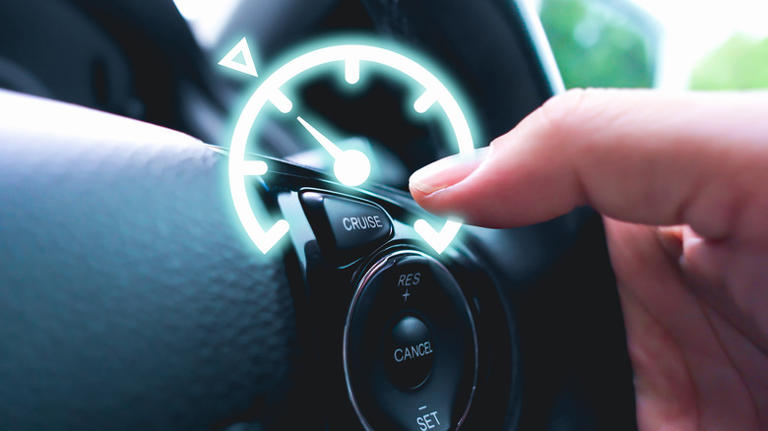
- What's My Car Worth?
- Buyer's Guide
How to Use Cruise Control Safely
Everything you need to know for safe, stress-free driving with your car's cruise-control system.

Its Job Is to Maintain Speed
Cruise control's primary function is to maintain the speed of your choosing, relieving you of needing to keep your foot on the throttle. Virtually all cars on the road today rely on an electronic control module—a computer—to monitor the vehicle's speed and to readjust it as needed to hold the speed you've chosen regardless of the road's gradient.

Know the Controls
You operate cruise control by either a stalk on the steering column or several buttons on the steering wheel. These include an on-off switch; a "set" button to select the speed you want the car to maintain; and buttons or switches marked "+" and "—" that increase or decrease the speed after it has been set, often in 1-mph increments. A "cancel" button disengages the cruise-control system without shutting it off entirely, allowing the car to coast. (Cars with stalk-operated cruise control have a "cancel" position that you move the stalk to in order to disengage the system.) A "resume" function or button brings the car back to its previously set speed. Braking or depressing the clutch at any time will also cancel cruise control. Should you need to make a quick pass, you can always override the preset speed by simply pressing down further on the gas pedal.
Adaptive Cruise's Added Features
Many newer cars offer what's known as adaptive cruise control, sometimes also called active cruise. It works in the same way as conventional cruise systems and additionally relies on front-mounted radar , cameras, or sensors to detect the presence of vehicles directly ahead in your lane. This enables adaptive cruise-control systems to maintain a set distance from the vehicle in front no matter how it varies its speed.
Adaptive systems allow you to adjust how closely your vehicle follows the one ahead but are programmed so that they always maintain at least a safe minimum following distance. Some of these systems also have the ability to brake and even come to a complete stop in city traffic and, depending on the vehicle, automatically accelerate without the driver pressing the gas pedal when traffic starts to move again.
Semi-Autonomous Cruise Control
Finally, the newest, most advanced cruise control systems, such as such as Nissan ProPilot Assist, Subaru EyeSight, and Audi Traffic Jam Assist, are semi-automated driving assistants that combine adaptive cruise control with lane-keeping assist, which self-steers the car gently to keep it in lane if you let it wander out—although you can only take your hands off the wheel for a few seconds before the system sounds alarms and then shuts off.
.css-1rvrtxn{font-family:Gliko,Gliko-fallback,Gliko-roboto,Gliko-local,Georgia,Times,Serif;font-size:1.625rem;line-height:1.2;margin:0rem;-webkit-text-decoration:underline;text-decoration:underline;text-decoration-color:#DBCA8B;text-decoration-thickness:0.25rem;}@media(max-width: 48rem){.css-1rvrtxn{font-size:2.25rem;line-height:1.1;}}@media(min-width: 48rem){.css-1rvrtxn{font-size:2.625rem;line-height:1.1;}}@media(min-width: 64rem){.css-1rvrtxn{font-size:3rem;line-height:1.1;}}.css-1rvrtxn b,.css-1rvrtxn strong{font-family:inherit;font-weight:bold;}.css-1rvrtxn em,.css-1rvrtxn i{font-style:italic;font-family:inherit;} No matter what type of cruise control your car has, the rules for using it safely are the same.
Most of these systems also can autonomously negotiate only the most gentle curves on the interstate. Some semi-autonomous systems, such as those from Tesla and Mercedes-Benz , can do more, including steering the car into the adjacent lane while keeping enough distance from other cars.
Follow These Safety Rules
No matter which type of cruise control your car has, the guidelines for using it effectively and safely are the same:
- Always remain alert and aware of other traffic, and be ready to take control and brake or steer around obstacles, inattentive drivers, or emergency situations.
- Think of even the most advanced adaptive and semi-autonomous cruise control systems as "dumb." They are programmed by humans and may react unpredictably in certain, unforeseen conditions. (See previous point: "remain alert.") Rain, snow, and fog can obscure radar signals and confuse cameras or sensors, sometimes disabling adaptive cruise control entirely. As with conventional cruise control, with an advanced cruise system you must always be prepared to take full control at a moment's notice.
- Cruise control is still best suited for use on highways and in light traffic. If your vehicle has conventional (not adaptive) cruise control, be sure to leave adequate spacing between your car and those ahead, and be prepared to disengage the system by braking or tapping "cancel" as you creep up on other vehicles or get into heavy traffic.
- Do not use cruise control in slippery conditions, including snowy or icy roads or rain-soaked roads awash in deep puddles. Most cruise systems will attempt to maintain your speed until you intervene, and on slippery roads that could cause you to momentarily lose traction, upsetting the car and potentially precipitating an accident.
Treat cruise control as a simple labor-saving convenience, however—but one that must be monitored—and you'll enjoy many miles of comfortable, stress-free travel.
Clifford Atiyeh is a reporter and photographer for Car and Driver , specializing in business, government, and litigation news. He is president of the New England Motor Press Association and committed to saving both manuals and old Volvos.

.css-1updq97:before{background-color:#000000;color:#fff;left:0;width:50%;border:0 solid transparent;bottom:48%;height:0.125rem;content:'';position:absolute;z-index:-2000000;} Features .css-1e2ieb7:after{background-color:#000000;color:#fff;right:0;width:50%;border:0 solid transparent;bottom:48%;height:0.125rem;content:'';position:absolute;z-index:-2000000;}
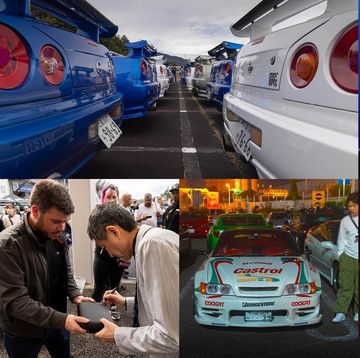
Pilot vs. Passport: Comparing Honda SUVs

The Winningest Cars in 10Best History
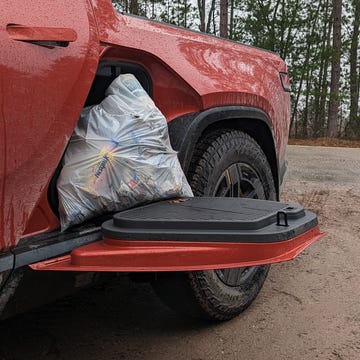
We Fill a Rivian R1T with Garbage for Earth Day

Most Fuel-Efficient Gas Cars (That Aren't Hybrid)
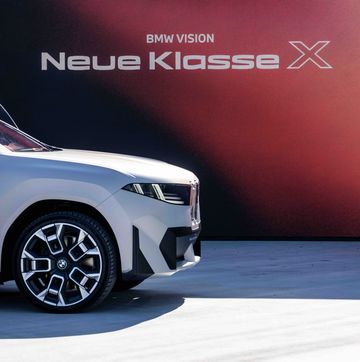
BMW Puts Brains on the Menu with Neue Klasse

The Best Odds: Alfa Romeo Milano

Seeing the Eclipse from the Ford Bronco Off-Roadeo
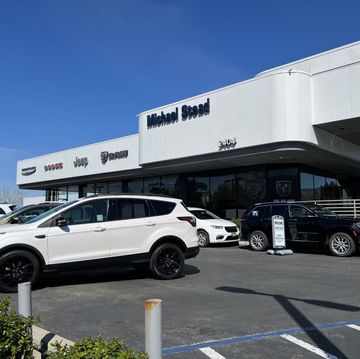
Buying a New Car: What to Know, How to Do It

The 2024 Toyota Tacoma is a Living Legend
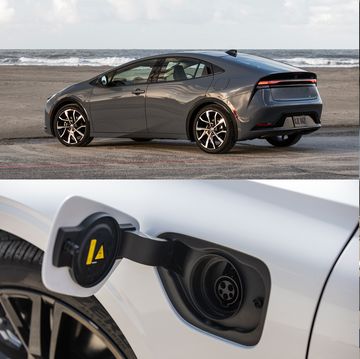
Every Plug-In-Hybrid Vehicle for Sale in the U.S.
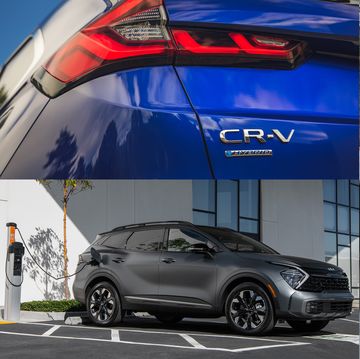
Best Compact Hybrid SUVs of 2024
Please turn on JavaScript in your browser It appears your web browser is not using JavaScript. Without it, some pages won't work properly. Please adjust the settings in your browser to make sure JavaScript is turned on.
How does cruise control work.
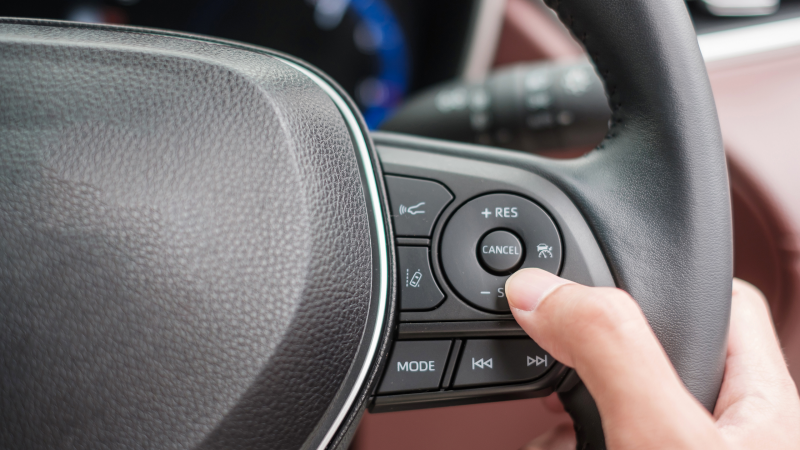
Cruise control is more than just a catchy name — it's a feature that you may just find in your own vehicle. There’s a good chance you might’ve even asked yourself “How does cruise control work?” after spotting it on your steering wheel. Read on to learn more.
What is cruise control?
Cruise control is an automated vehicle system that can manage your car’s acceleration to keep it traveling at a steady speed. This can be quite useful to drivers who are covering long distances on relatively straight roads, as it spares them the fatigue of keeping their foot on the gas for extended stretches of time. Other possible benefits include:
- Increased fuel efficiency from keeping a constant speed.
- Less distraction from speed adjustments, so the driver can pay more attention to the road.
Cruise control systems typically work by adjusting your car’s throttle, which moderates the air going to the engine. In older cars, this was done with a system of physical cables connected to the throttle valve, but newer cars have electronic systems that can adjust the car’s speed with an even higher degree of precision. A system of sensors constantly relays information about the car’s speed back to the cruise control system, which adjusts the throttle accordingly to maintain the desired speed.
The specifics of using a car’s cruise control vary quite a bit from car to car. It’s best practice to consult the owner’s manual for your car for precise information, but some basics are included below:
- Most cruise control systems typically have a button labeled “Set.” When you press this button, the system will engage cruise control at whatever speed you’re currently travelling. Some systems may also have an option to set a higher speed by pressing or holding the button down.
- Stepping on the brakes at any point will disengage the cruise control, while pressing the “Resume” button will return the car to the set speed.
- There is typically also an “Off” button, which will automatically shut off the cruise control when pressed.
- Most cruise control systems typically won’t activate below a certain speed limit. The exact limit may vary by car but is often somewhere in the range of 30-40 miles per hour.
Adaptive cruise control vs. standard cruise control
By now, you may have picked up on a potential drawback of cruise control — keeping a steady speed is harder to do (and possibly dangerous) when there are other drivers in front of you. This is why car makers invented adaptive cruise control.
With adaptive cruise control, your car uses radar and laser sensors to detect the speed of vehicles ahead and then adjusts your own speed accordingly to keep a safe distance. So, if the car in front of you slows down, your car will too. Once they’re out of the way, your adaptive cruise control will accelerate back to the speed you previously set. Standard cruise control, on the other hand, requires you to manually turn off the cruise control (or automatically disengage it by pressing on the brakes) when you notice traffic up ahead.
When to use cruise control
Cruise control was originally designed to be used on long drives and road trips when it’s possible to maintain a constant speed. Highway driving is still the typical time to deploy your cruise control, but the development of adaptive cruise control has made it possible to potentially use your cruise control for certain city driving scenarios as well.
When not to use cruise control
It’s also important to know when not to use cruise control. It's generally best to avoid using this feature when:
- There’s a lot of traffic on the road, and it would be difficult to hold one steady speed for long.
- The roads are wet or icy, as it may limit your ability to decelerate or stop quickly enough if you start hydroplaning .
- You’re fatigued, as the ability to relax your legs may increase the risk of potentially falling asleep behind the wheel.
Cruise control is more than simply a modern convenience. In the right circumstances, it can potentially enhance your driving experience by reducing fatigue, increasing safety and improving fuel efficiency. If you’re still wondering “How does cruise control work?,” perhaps it’s time to take the leap and try it out for yourself the next time you’re shopping for a new car.
- car features
What to read next
Maintaining a car what are advanced driver assistance systems.
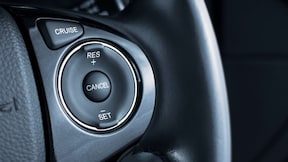
Advanced driver assistance systems (ADAS) can help you avoid collisions and alert you to safety problems. Learn more about how ADAS technology can be helpful.
maintaining a car Road trip essentials: How to plan and pack
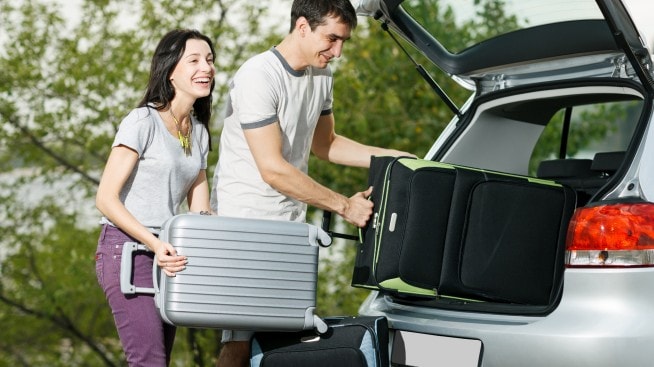
Are you thinking about going on a road trip? Before doing so, read through the article to know how to plan for a road trip and what to pack for the trip.
maintaining a car What to know about child booster seats
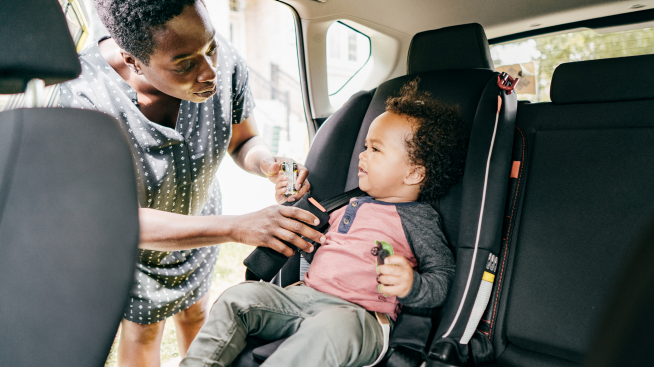
As your child grows, you may need to transition to a child booster seat in the car. Learn more about the features and safety factors to consider when looking for a booster seat.
maintaining a car Carpooling benefits and how to get started
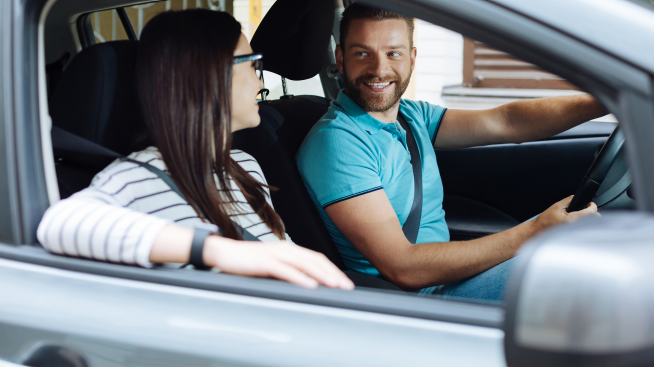
There are many benefits to carpooling such as environmental, social and financial. Read through the article to learn more!
Cruise Control In Cars Explained (And How To Safely Use It)

Have you ever wished you could set your car's speed and just sit back and relax while driving on a long stretch of highway? If that's the case, then cruise control is just the ticket you've been searching for—and the good news is, it's a standard feature in most cars these days!
Cruise control is a handy feature for drivers that allows you to maintain a constant speed without having to keep your foot on the gas pedal. In this post, we'll explore how cruise control works, its benefits, and how to use it safely to make your driving experience more comfortable.
Understanding Cruise Control
Cruise control, also known as speed control, is an electronic system that allows you to maintain a specific speed without manually controlling the accelerator pedal. The system uses sensors and electronic components to control the throttle and keep your car moving at a desired speed. First introduced in the late 1950s, cruise control has since become a standard feature in most modern vehicles you see on the road today.
How Does It Work?
At its core, cruise control involves a series of sensors that monitor the vehicle's speed and a control unit that regulates the throttle. When the driver sets the cruise control to a specific speed, the system adjusts the throttle to maintain that speed. If the car begins to slow down because of an incline (e.g. going up a hill), the system will open the throttle to accelerate. Conversely, if the car starts to speed up due to a declin (e.g. going downhill), the system will close the throttle to decelerate.
Modern cruise control systems also come with additional features like adaptive cruise control (ACC), which uses radar or cameras to detect vehicles ahead and automatically adjusts the speed to maintain a safe following distance (more on this BELOW).
The History of Cruise Control
The invention of cruise control can be traced back to the late 1940s and early 1950s, when engineer Ralph Teetor developed the first-speed control system. This innovative feature was designed to help drivers maintain a steady speed, reduce fatigue while driving, and improve fuel efficiency. Over the years, cruise control technology has undergone significant advancements, leading to the development of sophisticated systems like adaptive cruise control.
Types of Cruise Control Systems
Today, drivers can choose from a range of cruise control systems, each with its own unique features and functionalities.
Conventional Cruise Control
Conventional cruise control is like your old reliable friend. It's pretty basic and doesn't have any fancy bells and whistles. You just set the speed you want, and it'll keep your car cruising along at that speed, no problem. It's perfect for those long drives on open highways, but it doesn’t automatically react to other cars on the road.
So, if the car in front of you slows down, you'll need to step in and adjust your speed manually. This trusty system comes standard on most cars and is great for saving some fuel on those long road trips .
Adaptive Cruise Control (ACC)
Now, if conventional cruise control is your old reliable friend, then Adaptive Cruise Control (ACC) is like that friend's tech-savvy younger cousin. ACC isn't just maintaining your set speed, it's also keeping an eye on the car in front of you. If that car slows down, ACC slows your car down to keep a safe distance .
It's like having an extra set of eyes on the road, making highway driving a breeze. Plus, some ACC systems can even handle stop-and-go traffic, bringing your car to a full stop and then picking up speed again when traffic gets moving.
Predictive Cruise Control
Predictive Cruise Control is like the fortune teller of cruise control systems. It uses GPS and map data to see into the future and predict what's coming up on the road, like hills or curves, and adjusts your speed accordingly. This means you get a smoother ride and better fuel efficiency, but it all depends on the quality of the GPS and map data. If that's a bit out of date, your fortune-telling cruise control might not be so accurate. It's usually found in more high-end vehicles where top-notch fuel efficiency is a focus for the engineers.
Cooperative Adaptive Cruise Control (CACC)
And then we have Cooperative Adaptive Cruise Control, or CACC. This is like the team player of cruise control systems. It allows cars to talk to each other, coordinating their speeds to maintain a safe distance. It's like having a well-coordinated team of cars all working together to make the traffic flow smoother and reduce congestion. Picture it like a synchronized dance on the highway, where every car knows its place and keeps the right distance. This tech is still pretty new, but it's got a lot of potential. Imagine a future where traffic jams could be a thing of the past.
Remember, these systems are here to make your drive smoother and safer, but they're not a replacement for your attention. No matter how fancy your cruise control is, these systems can be greatly influenced by external conditions like weather and traffic, and they should always be used as aids, not replacements, for attentive driving.
Common Cruise Control Symbols and Indicators
Understanding the various symbols and indicators associated with cruise control is important for safe and effective usage. These symbols typically appear on the dashboard (or on the side of the steering wheel) and may include a speedometer icon, "SET," "RES" (resume), and "CANCEL". Be sure to consult your vehicle's owner's manual for specific details and explanations of these symbols.
Benefits of Using Cruise Control
Cruise control offers several benefits to drivers, especially during long road trips or highway driving.
Fuel Efficiency
One of the main advantages of using cruise control is improved fuel efficiency. By maintaining a constant speed, cruise control helps reduce fuel consumption, leading to better gas mileage. Rapid acceleration and deceleration, on the other hand, can lead to increased fuel consumption.
Comfort and Convenience
Cruise control allows drivers to take their foot off the accelerator pedal, reducing fatigue and improving comfort during long drives. It also helps drivers avoid unintentionally exceeding the speed limit by setting a maximum speed.
When used correctly, cruise control can contribute to safer driving. By maintaining a steady speed, it reduces the likelihood of erratic driving behavior and potential accidents. However, it is important to note that cruise control shouldn't be used in certain conditions, such as heavy traffic or slippery roads .
Troubleshooting Common Cruise Control Issues
Occasionally, you may encounter issues with your cruise control systems. Common problems include cruise control not engaging or disengaging unexpectedly. Possible causes may include a faulty brake light switch, malfunctioning sensors, or issues with the control module. If you experience any problems with your cruise control, it's best to have a qualified technician diagnose and repair the issue for you.
Cruise Control and Road Etiquette
Practicing proper road etiquette while using cruise control is essential for a safe and pleasant driving experience. Here are some tips on how to use cruise control courteously:
- Avoid using cruise control in heavy or congested traffic, as it may hinder your ability to react quickly to changing conditions.
- Be mindful of other drivers when setting your speed. Avoid setting a speed that's significantly slower or faster than the flow of traffic.
- If you are in the passing lane and using cruise control, be sure to adjust your speed or temporarily disengage the system to allow faster-moving vehicles to pass.
- Always signal your intentions, such as lane changes or exiting the highway, even when using cruise control.
The Future of Cruise Control Technology
Cruise control technology plays a vital role in the development of autonomous vehicles, or self-driving cars . In autonomous vehicles, cruise control systems work together with other advanced driver assistance systems (ADAS) to enable the vehicle to operate without direct driver input. These systems include lane-keeping assist, automatic emergency braking, and collision avoidance systems.
As autonomous vehicles become more sophisticated, cruise control technology is evolving to support higher levels of automation. For example, some autonomous vehicles are equipped with advanced cruise control systems that can navigate complex traffic scenarios, merge onto highways, and even change lanes autonomously.
While fully autonomous vehicles are still in the developmental stages, the integration of cruise control technology is a big step toward creating safer and more efficient transportation systems.
As automotive tech continues to advance, cruise control systems are becoming more intelligent and capable. Here are some potential developments we can expect to see in the future of cruise control technology:
- Integration of artificial intelligence (AI) to improve decision-making and responsiveness in adaptive cruise control systems.
- Enhanced connectivity and vehicle-to-vehicle (V2V) communication, enabling cars to share information about traffic conditions and coordinate their speeds for smoother traffic flow.
- Greater customization and personalization options, allowing drivers to set preferences for cruise control behavior, such as following distance and speed adjustments.
Overall, the future of cruise control technology holds promise for creating a more seamless and enjoyable driving experience, with a focus on safety, comfort, and sustainability.
Debunking Myths About Cruise Control
Let's address and debunk some common misconceptions about cruise control:
Myth : Cruise control can be used as a substitute for driver attention.
Fact : Cruise control is a driver assistance feature, not a replacement for attentive driving. Drivers should always remain alert and ready to take control when necessary.
Myth : Cruise control increases the risk of accidents.
Fact : When used appropriately, cruise control can contribute to safer driving by maintaining a steady speed and reducing erratic driving behavior.
Cruise control is a valuable feature that can enhance your driving experience by providing comfort, convenience, and fuel efficiency. Remember to use it safely and appropriately based on driving conditions, and always stay attentive while on the road.
If you found this post informative and want to learn more about car features, driving tips, and automotive technology, be sure to subscribe to our newsletter for regular updates. We're here to help you stay informed and enhance your driving experience.
Frequently Asked Questions About Cruise Control
To further enhance your understanding of cruise control, here are answers to some common questions:
Q : Can cruise control be used in all weather conditions?
A : It isn't advisable to use cruise control in adverse weather conditions, such as heavy rain, snow, or icy roads, as it may reduce your ability to respond quickly to changing road conditions.
Q : Can I use cruise control in urban areas with frequent stop-and-go traffic?
A : Cruise control is best suited for open roads and highways with consistent traffic flow. It isn't recommended for use in urban areas with frequent stops or heavy traffic.
Q : Does cruise control work at any speed?
A : Cruise control typically has a minimum speed threshold, below which it can't be engaged. This threshold varies by vehicle, so check your owner's manual for specific information.
About the Author: This article was crafted by the LOOP Marketing Team. Comprising of seasoned professionals with expertise in the insurance industry, our team is dedicated to providing readers with accurate, up-to-date, and valuable information. At LOOP, we're passionate about helping families navigate the world of car insurance, ensuring they get the best coverage at the most affordable rates. Learn more about our mission and values here.
For more insights on auto insurance and other related topics, visit our blog .
Quick Navigation
Check out how much you could save today.
Browse related articles

Are Sundays Safe Days To Drive?

Ensuring Safe Long-Distance Driving After Dark

Complete Guide To A Defensive Driving Course: Benefits, Duration, And Cost
Life has many roads. your weekly navigator is just a click away..
- Tips & advice
Cruise control and adaptive cruise control: the complete guide
Cruise control is a great extra to have if you do regular motorway journeys, while adaptive cruise control arguably makes even more sense.

What is cruise control? Cruise control is an electronic system that automatically regulates a car's speed without the driver having to keep their foot on the accelerator. That's the simple answer, but today car manufacturers are adding ever-more advanced cruise control systems to their models, all designed to make driving easier and safer, while many of the newer technologies are on the first tentative steps towards autonomous vehicles .
Once upon a time, cruise control was the preserve of high-end luxury cars, but as the technology has become more affordable, car makers have rolled it out on more mainstream models. Today, you can get it on even the smallest city cars , while other models get a proprietary speed limited system that requires a bit more input from the driver.
• What is AEB?
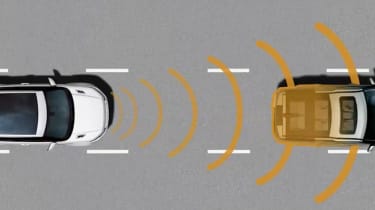
Elsewhere, the progress of technology means that car makers have been able to develop adaptive cruise control (ACC) systems that can vary a car's speed according to traffic, while the most advanced systems are on the steps towards fully autonomous driving.
Here we explain how cruise control works and break down the different kinds of system on offer, highlighting their advantages and limitations, so you can decide if it's an option that's worth ticking on your next new car purchase.
Cruise control history
Cruise control can trace its origins back to the 17th and 18th century, when engineers developed 'speed control' systems for steam engines. These mechanical systems were adapted by some early automobile makers at the start of the 20th century, although the predecessor to modern cruise control didn't appear until the 1950s.
The first car to feature cruise control was a 1958 Imperial, which was Chrysler's luxury division. Called 'Auto-pilot', the system was mechanical and was connected to the engine propshaft. It had a dial on the dashboard to preselect a speed and an electric motor that adjusted throttle position to maintain it.
US firm American Motors produced a budget version of cruise control for its automatic cars in 1965, but cruise control really took off in the US during the oil crisis of 1973. Manufacturers had developed electronic cruise control systems by this time, and these makers promoted the benefits of the system as it delivered constant throttle inputs, rather than the erratic flexing of the driver's right foot for improved fuel economy.
• What is horsepower?
Cruise control found popularity in the US first because of that nation's fondness of automatic gearboxes, long travelling distances and the relatively straight and wide highway network. In Europe, cruise control took a little longer to gain a foothold, but like the US, it first appeared on high-end luxury cars before filtering its way down to more mainstream models.
The first adaptive cruise control (ACC) system appeared in Japan in the early 1990s, although the first systems simply warned the driver of slower traffic ahead, and didn't control the car's throttle or brakes.
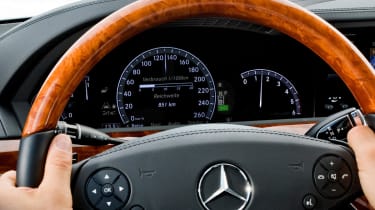
The first proper ACC system was Mercedes ' Distronic system, which appeared on the S-Class limousine in 1999. This system not only controlled the throttle, but also the brakes to maintain a set distance to the vehicle in front.
Since then, car makers have embraced ACC, and it can be found on superminis , hatchbacks and sports cars , while the rising level of traffic on our roads means it's arguably a more useful feature than standard cruise control on its own, as it can adjust speed according to traffic flow.
• What is 4x4? All-wheel-drive systems explained
How does cruise control work?
Modern cruise control systems are integrated into a car's electronics, and are often combined with additional tech, such as lane departure warning and blind spot sensors. With standard cruise control, you need to select cruise mode via a switch, then accelerate to your desired speed, and press a button – either on the steering wheel or on a lever on the steering column - to set that speed.
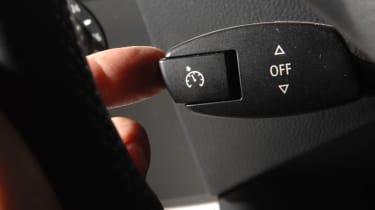
The car's electronics then maintain your selected speed, so you can take your foot of the accelerator. On some cars you can adjust your speed via a button, and the car will automatically change its speed accordingly.
On a car with adaptive cruise control (ACC), you switch on the system, then you can raise or lower your speed as desired, and the car will accelerate to that set speed. These systems use either radar or laser sensors to maintain a set distance to the car in front, and they also have the ability to increase or decrease that distance as required.
To deactivate cruise control, you simply press a button to regain control of the throttle. However, one important safety feature that all of these systems are required to have is that the system will immediately deactivate if the car's brakes are applied. On cars with a manual gearbox, pressing the clutch pedal will sometimes have the same effect, although not all cars behave in the same way. Most cars will have a memory function, so that you can resume the same speed after the brakes have been applied.
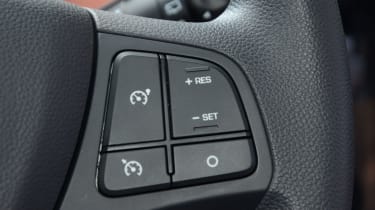
Earlier cruise control systems would have a lower speed threshold of around 20-30mph where cruise control couldn't be activated, and some manufacturers still maintain this set-up. However, some of the latest ACC systems also incorporate a traffic function, so they can operate in stop-start conditions.
Cruise control types
Essentially there are four types of cruise control on offer, ranging from the most basic speed limiter to systems that can negotiate stop-start traffic and even change lanes. We look at the benefits and disadvantages of each below.
Speed limiter
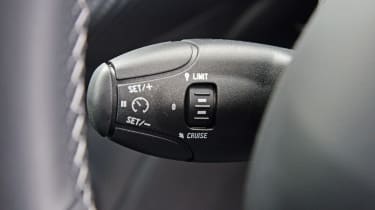
What is it? The most basic form of cruise control. There are systems that can be hard-wired into a vehicle to limit its top speed (a 70mph limit in vans, for example), or there are driver-activated systems. You can set a maximum speed for your vehicle, but you maintain control of the car's accelerator at all times. When you approach your set maximum, the car will simply stop accelerating. This will usually happen softly, so you'll barely notice.
Found on: Citroen, Ford, Nissan, Peugeot, Renault, vans, can be added aftermarket, too. Advantages: Helps you stick to speed limits, saves fuel. Disadvantages: Driver has to continue using the throttle to maintain speed.
Cruise control

What is it? Standard cruise control is a fairly common feature on new cars. You turn the system on (usually indicated by a graphic on the dashboard), then once you're up to your desired speed, you press a button to set it, and the car maintains that speed.
Found on: Most mainstream new cars, except for the most basic trims. Advantages: Takes strain out of long drives, more fuel efficient than using the accelerator manually, helps you stick to speed limits. Disadvantages: Driver has to take over when traffic slows, only worth using on clear motorways.
Adaptive cruise control
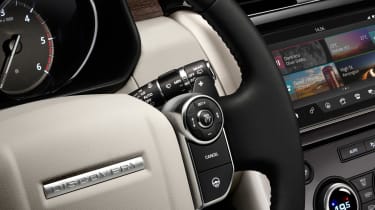
What is it? Either a radar or laser-based system that can maintain speed, but reduces speed if the gap to the car in front falls below a preset distance. This constitutes Level One automation on the automated vehicle classification chart, as they driver is required to take control at any time.
Found on: Assorted BMW, Fiat group, Ford, JLR, Lexus, Mercedes, VW Group models, and increasing in use by other makers. Advantages: Adjusts speed according to traffic, takes strain out of long drives, helps fuel efficiency. Disadvantages: Sensors can be 'blinded' in bad weather, electronics can be slow to react to sudden traffic slowing, distance to the car in front can be big enough to tempt other drivers to cut in front of you, sometime systems are jerky when changing speed.
Semi-autonomous cruise control
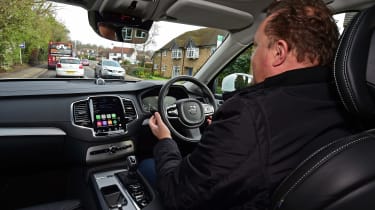
The latest hi-tech cruise control systems are one step closer to the fully autonomous self-driving car, and are classed as Level 2 automation. This means the automation can control the throttle, brakes and steering, but the driver still needs to intervene if the systems fail to detect objects. Semi-autonomous systems can vary in sophistication, and can help with steering inputs, move in stop-start traffic, or even change lanes on the motorway with the flick of an indicator, or adjust the car's speed according to GPS data and road sign recognition cameras.
Found on: Audi A3 /A8/Q7, BMW 7 Series , Mercedes S-Class , Volvo XC90 Advantages: Takes strain out of driving and traffic jams, helps fuel consumption. Disadvantages: Sensors need to be kept clear for it to work, too easy for driver to 'switch off' and lose concentration.
Do you have cruise control or adaptive cruise control on your car? Do you use it? Let us know what you think of the technology in the comments...
Dean has been part of the Auto Express team for more than 20 years, and has worked across nearly all departments, starting on magazine production, then moving to road tests and reviews. He's our resident van expert, but covers everything from scooters and motorbikes to supercars and consumer products.
Most Popular
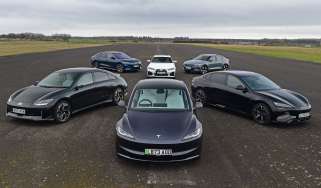
Tesla Model 3 vs its five biggest rivals
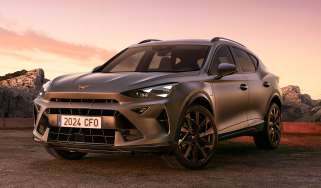
New 2024 Cupra Formentor gets fresh look and power boosts to keep hot streak going
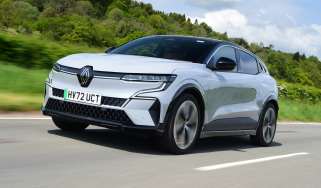
Renault Megane E-Tech gets extra kit but is now cheaper than ever
Enter your email below to receive occasional updates in your inbox.
- < Back to email setting
Cruise Control: What It Is and How to Use It
How to use cruise control.
The location of the cruise control buttons can vary per car. For your car, check the manufacturer’s manual for the location and specific instructions. To set cruise control, press the ON/OFF button or switch. If you press this button again, it typically turns the system off. The Res + (resume / increase seed) button increases the cruising speed by 1 mph, while the Set – (set speed / reduce speed) button decreases it by 1 mph. To shut off the cruise control, you can press the Cancel button or simply press the brake pedal. [1]
What is cruise control?
Cruise control locks your car’s accelerator at a specific speed, allowing you to take your foot off the pedal and remain at a constant speed. Because it’s so convenient for commuters and drivers who use the highway frequently, cruise control is a feature that generally comes standard on most models of cars. [2]

What is adaptive cruise control?
Adaptive cruise control is very similar to conventional cruise control, only it automatically adjusts the speed of your vehicle depending on how fast the vehicle in front of you is going. It may also reduce your speed around tight curves and adjust to speed limit changes, depending on your car’s technology. [3]
How to set cruise control
Follow these steps when setting the cruise control:
- Evaluate weather conditions: Check for hazardous weather conditions and any oncoming obstacles before applying cruise control.
- Build your speed: The ideal speed for cruise control is between 55 and 70 mph.
- Turn cruise control on: The button is usually on or near your steering wheel.
- Set cruise control: Press another button on your steering wheel and remove your foot from the accelerator.
- Watch the road carefully: You will have a slower reaction time if your foot is off of the brake or accelerator pedal. [1]
How does cruise control work?
Cruise control adjusts the throttle position in your car to control your speed. It does this by a cable connected to an actuator, instead of just by pressing the pedal to adjust the speed. [4]
Cruise control safety tips
Follow these safety tips while using cruise control on the road:
- Use it only on highways: Roads with lower speeds often have traffic lights, turns and other cars that require frequent stops.
- Don’t use it in heavy traffic: If you hit traffic and use the brakes a lot, cruise control isn’t ideal.
- Don’t use it on wet streets: Wet roads are dangerous, and it’s important to keep control of your car and its speed in those conditions.
- Keep your distance from other cars: A set speed could cause you to get dangerously close to other vehicles. Not every car as the distance-monitoring system that adjusts your car’s speed based on what’s in front of you.
- Hover your foot over the brake: Always be prepared to break whenever necessary.
- Be aware of your surroundings: Look out for other cars on the road and stay in your lane. [5]
Cruise control when it’s raining
Avoid using cruise control when the roads are wet . You might not be able to stop as quickly as you’d like when using cruise control. This could lead to dangerous situations and even accidents. Wet roads can affect your car’s ability to maintain a constant speed. There’s even a possibility if you’re using cruise control while it’s raining that your vehicle could hydroplane . [6]
Frequently asked questions about cruise control
Does cruise control save gas.
Cruise control can help you save an average of 7% to 14% on gas. When you don’t use cruise control and constantly press the accelerator and brake pedals, more gas is usually used. Cruise control works best to save gas when driving on flat roads that are free of congestion. [7]
Is cruise control bad for your card?
In general, cruise control isn’t bad for your car. It can actually reduce heavy acceleration and deceleration. It doesn’t damage your car in any way, and the frequent use of it doesn’t affect your vehicle. [8]
Is cruise control safe?
Cruise control is convenient for long stretches of driving and it can keep you from speeding if you set your speed to the correct limit. However, if the road conditions are rainy or snowy, cruise control can be dangerous. To use cruise control safely, it’s best to know when you should and shouldn’t use it. [9] Using cruise control on the highway makes your driving more predictable to other drivers. Instead of constantly changing speeds, cars know how fast you’re driving and can follow safely behind you or pass.
When should cruise control not be used?
You shouldn’t use cruise control in the following conditions:
- When the roads are wet and slippery.
- During heavy traffic.
- On hills and winding roads. [9]
[1] “What is cruise control?” kia.com/dm/discover-kia/ask/what-is-cruise-control.html (accessed July 11, 2023).
[2] “How to Use Cruise Control: 7 Specific Things You Need to Know Well,” driving-tests.org/beginner-drivers/how-to-use-cruise-control (accessed July 11, 2023).
[3] “What Is Adaptive Cruise Control? Is It Worth Paying For?” Stefan Ogbac, motortrend.com/features/adaptive-cruise-control (accessed June 2, 2020).
[4] “How Cruise Control Systems Work,” Karim Nice auto.howstuffworks.com/cruise-control.htm (accessed Feb. 9, 2021).
[5] “6 Cruise Control Safety Tips You Should Never Ignore,” Marisol Pereira and Carrie Adkins, getjerry.com/advice/6-cruise-control-safety-tips-you-should-never-ignore-by-marisol-pereira (accessed April 27, 2022).
[6] “How Does the Cruise Control in Cars Work?” mapfreinsurance.com/blog/how-does-cruise-control-in-cars-work (accessed July 11, 2023).
[7] “Does cruise control save gas?” kia.com/dm/discover-kia/ask/does-cruise-control-save-gas.html (accessed July 11, 2023).
[8] “Everything You Need to Know about Cruise Control,” Dave Johnston, mycarmakesnoise.com/electronics/cruise-control-guide (accessed July 11, 2023).
[9] “Is Cruise Control Safe to Use?” kaufmanlawatlanta.com/is-cruise-control-safe-to-use (accessed July 11, 2023).
Disclaimer:
The information included here is designed for informational purposes only. It is not legal, tax, financial or any other sort of advice, nor is it a substitute for such advice. The information may not apply to your specific situation. We have tried to make sure the information is accurate, but it could be outdated or even inaccurate in parts. It is the reader’s responsibility to comply with any applicable local, state or federal regulations. Nationwide Mutual Insurance Company, its affiliates and their employees make no warranties about the information nor guarantee of results, and they assume no liability in connection with the information provided. Nationwide and the Nationwide N and Eagle are service marks of Nationwide Mutual Insurance Company. © 2024 Nationwide
Related articles
Tire rotation overview: why and when to do it.
Keeping your tires in good condition can be the difference between a safe ride and an accident. If your tires wear or get misaligned over time, this can lead to...
Why Are My Brakes Making Noise?
Have you ever been confused as to the sounds coming from your vehicle when you brake? From grinding and rattling to thumping and squealing, you can learn how to decode...
12 Common Car Noises and What They Mean
One minute you’re driving your car and everything seems fine, and the next moment you hear a strange noise coming from your car as you accelerate. There are some normal...
Ram ends sales of the Ram Classic 1500 pickup in Canada
Most efficient hybrid vehicles in every major category, suv comparison: 2024 mazda cx-50 vs toyota rav4, ev review: 2024 kia ev9 real-world range test, canada's best-selling cars, trucks, suvs, and auto brands in 2024's first-quarter, what is cruise control a comprehensive guide.
When the system is set, cruise control will maintain a steady speed for your vehicle
You can save this article by registering for free here . Or sign-in if you have an account.
Article content
Your vehicle’s cruise control system unlocks numerous benefits at the touch of a button — but according to web search data, drivers still have plenty of questions about what it is, what it does, and how it works.
What is Cruise Control? A Comprehensive Guide Back to video
Below, we’ll answer some of the most popular Internet search questions about cruise control, so you can make the best use of this important system.
What is Cruise Control?
With cruise control, your vehicle will maintain a steady speed when the system is set.
What is adaptive cruise control?
With adaptive cruise control, the vehicle will also automatically slow down and speed up to maintain a safe position in traffic.
How does cruise control work?
Cruise control work with a manual transmission just the same way it does with an automatic. Drivers set their cruising speed with a button press, and the system works the throttle automatically to maintain the desired cruising speed as evenly as possible. In some vehicles with a manual transmission, pressing the clutch pedal to shift gears turns the cruise control off, requiring an additional button press to reengage it after a gear change.
In other cars with a manual transmission, pressing the clutch pedal simply pauses the cruise control system a moment, allowing drivers to complete their gearshift. When they’ve released the clutch, the cruise control picks up where it left off — no additional button press required.
Is cruise control more fuel efficient?
Yes. Increasing your vehicle’s speed uses fuel. While cruising, even a highly competent driver who isn’t using cruise control will tend to slow down and speed up in a repeated cycle, possibly several times per minute. Though fluctuations in speed may be slight, they do cause your engine to use more fuel than required. Point is, the more time you spend at a steady speed, the less fuel your engine needs.
For most drivers, using cruise control on the highway at 80 km/h can reduce fuel consumption by about 20 per cent. For drivers who find difficulty in maintaining a steady speed and frequently experience big fluctuations, using cruise control can cut fuel use by over 40 per cent.
Depending on what you drive and how fast you drive it, using cruise control could save you between $4 and $20 per hour — based on information from Natural Resources Canada that shows most drivers who don’t use cruise control on the highway will tend to experience a 10 km/h speed fluctuation about three times per minute.
Drivers who have the most difficulty managing their cruising speed could be using 60 per cent more fuel than they need to.
Is cruise control bad for your transmission?
No. Your vehicle’s engine, transmission and other components are designed to work hand-in-hand with its cruise control system and are extensively tested and integrated with one another for trouble-free performance.
Using cruise control also reduces wear and tear on both your engine and transmission by running things more smoothly and steadily, and reducing workload on both components.
Can you add cruise control to a car?
Yes. Depending on the year, make and model, cruise control may be available for add-on or retrofit. Professional installation is recommended, and you’ll want to talk to a professional about the specific availability of parts and integration for your vehicle.
In many cases with modern cars, it’s generally easier and more cost effective to just opt for a unit equipped with cruise control from the factory. Cruise control is widely available as standard equipment on most modern vehicles.
Can cruise control get stuck?
Yes , but it’s extremely rare. Older cable-based cruise control systems seem more prone to this rare problem, in which the cable can slip or bind, making the throttle stick into position. More modern vehicles with electronic throttle and monitoring systems make this problem even less likely.
If the cruise control on your car fails to disengage when you want to slow down, slip the vehicle into neutral to disconnect drive power from the wheels, pull over, and address the situation.
However, chances are, you’ll never experience this problem.
When should cruise control be used?
Any time you’re trying to drive at a constant speed. Whether around town at 60 km/h, in a residential area at 40 km/h, or out on the highway at 105 km/h, switching the cruise control on makes for a smoother and more fuel efficient drive that’s easier on your engine and transmission. it can also help you do your part to maintain the steady and efficient flow of traffic.
Most cruise control systems can be engaged at speeds above 30 km/h.
When should cruise control not be used?
Any time you can’t safely drive at a steady speed. If the road surface is snowy, icy, slushy or very wet, you’ll want to think twice about switching your cruise control on.
In older cars, having your cruise control engaged on a wet or icy road could allow the vehicle to accelerate or experience wheelspin when driven wheels encounter a low-traction surface. Here, the cruise control system maintains throttle pressure, even in situations where it should be released instead. This could lead to a loss of control.
In more modern vehicles, electronic monitoring is used to automatically disengage cruise control when one of the following happens:
- one or more wheels slip
- one or more wheels leave the surface of the road after a major bump or dip
- the wipers are set to the maximum speed setting in heavy rain
Use your judgement. Safely navigating certain slippery or dangerous driving conditions requires careful manual control of your vehicle’s throttle, and in these situations, you’re best to leave the cruise control off.
What causes cruise control to kick off?
If the cruise control in your vehicle suddenly kicks off, a few things may be to blame.
Sometimes, cruise control disengages automatically when the vehicle’s automatic wipers detect heavy rainfall, or when a wheel spins or (briefly) leaves the surface of the road after a big bump or dip. In other situations, there may be a problem with one or more sensors or switches, including the brake pedal switch, throttle position sensor, or one or more wheel speed sensors.
Your modern cruise control system relies on various sensors and switches to do its job properly. As a failsafe, any problem with these sensors can cause the cruise control system to go offline. If you notice this happening regularly, have your vehicle diagnosed by a professional.
Will the cruise control work with an ABS light on?
Probably not. Your car’s Antilock Braking System works hand-in-hand with your cruise control system, and any fault with the ABS system will typically take your cruise control offline until it’s fixed.
An ABS warning light in your instrument cluster can indicate one of several major problems or malfunctions, so be sure to have a professional investigate as quickly as possible.
Will cruise control apply the brakes?
No, but adaptive cruise control will. Standard cruise control (simply called cruise control) holds your vehicle’s speed as constant as possible once set. More advanced adaptive cruise control systems use camera or radar-based sensing to determine the traffic situation in front of your vehicle, and can automatically apply the brakes to maintain a pre-set following distance.
With cruise control, drivers need to brake to slow down as they close in on a slower vehicle in traffic. With adaptive cruise control, the system makes these braking inputs automatically, and the vehicle speeds back up to its pre-set cruising speed once traffic clears.
Before you buy, be sure to determine which type of cruise control system is fitted to the car you’re considering.
What is Super Cruise?
Super Cruise is a next-level driver assistance feature available on certain GM vehicles.
With Super Cruise, the vehicle uses special GPS hardware and sensors to accurately compare its position to a 3D map of pre-qualified highways .
On these pre-qualified highways, Super Cruise allows drivers to go hands-free for extended periods as the vehicle automatically maintains its cruising speed, adjusts that speed for changing traffic conditions, and even precisely follows the curves in the road. It can even make hands-free lane changes.
Super Cruise is not an autonomous system, and in order for it to work, drivers need to keep their eyes on the road — there’s even a camera that monitors the position of the driver’s eyes to make sure they’re focused on the road ahead.
- Evolutionary: The Mercedes-Benz G-Wagen has never strayed far from its roots
- How to jump-start a car—a step-by-step guide
- Testing Mitsubishi’s AWD systems and Snow mode on ice
- 12 things to know about the 2025 Ram 1500 Ramcharger REx
- Ministry of Interior Affairs: How the Range Rover Sport SV's seats vibrate to your music
Justin Pritchard
Justin Pritchard is an experienced motoring expert whose work is read and watched by Canadians across the country on a weekly basis. Starting his career at Auto123.com back in 2005 (while finishing his final year of studies at Laurentian University in Sudbury, Ontario), Justin quickly applied his passion for writing, presenting, and photography, working under some of the most recognized editors in the Canadian motoring scene.
Justin has written one of the largest collections of used car buyer guides on the internet, and his TV program, AutoPilot, has aired over 600 episodes across 16 seasons. Presently, AutoPilot is the only English-language motoring program on Canadian cable TV, though he's lent his informative style and easy-to-identify voice to video features for Youtube, Driving.ca, Autotrader.ca, Motoring TV, and elsewhere. With 4 years as co-chair of the Canadian Car of the Year Awards (CCOTY) program, a passion for vehicle testing shines though in all of his work.
A passion for photography from a young age makes Justin as comfortable behind the camera as in front of it, and capturing motoring memories from the scenery of beautiful Northern Ontario is a priority in much of his work. The particularly harsh winter climate in this part of Canada makes Justin a particular expert on winter driving, winter tires, and extreme-weather safety.
Major awards won by the author
Contact info.
Youtube: @JustinPritchard
Postmedia is committed to maintaining a lively but civil forum for discussion. Please keep comments relevant and respectful. Comments may take up to an hour to appear on the site. You will receive an email if there is a reply to your comment, an update to a thread you follow or if a user you follow comments. Visit our Community Guidelines for more information.
Affordable EVs
Small trucks
Popular Crossover SUVs
Practical 3-row SUVs
Minivans for the whole family
Compact Cars
Luxury SUVs
Affordable AWD SUVs
All things automotive: breaking news, reviews and more. Wednesdays and Saturdays.
- There was an error, please provide a valid email address.
A welcome email is on its way. If you don't see it, please check your junk folder.
The next issue of Driving.ca's Blind-Spot Monitor will soon be in your inbox.
We encountered an issue signing you up. Please try again
Best retrofit Apple CarPlay and Android Auto units
You don't need to buy a new car to add Apple CarPlay or Android Auto.
5 Essential car accessories every driver should buy
There's lots of aftermarket gear out there, but get these add-ons first—they'll make your daily drive more comfortable and safe
The top 5 best motorcycle accessories we've tested
After 40 years of testing motorcycles, these are the five pieces of gear David Booth can’t and won’t live without
Tools you'll need for DIY tire swaps
Changing tires twice a year, it won’t take many seasonal swaps to pay for your investment
Top car organizers to declutter the cabin
Discover some of the top-rated car organizers that will help declutter the car and arrange belongings for a hassle free drive
This website uses cookies to personalize your content (including ads), and allows us to analyze our traffic. Read more about cookies here . By continuing to use our site, you agree to our Terms of Service and Privacy Policy .
Edit your picks to remove vehicles if you want to add different ones.
You can only add up to 5 vehicles to your picks.
Looks like you've reached your saved article limit!
You can manage your saved articles in your account and clicking the X located at the bottom right of the article.
What is cruise control in a car? Meaning and how does it work?
Cruising on the highway can be a lot of fun. However, it demands maintaining a constant speed for a long time. To achieve that, you need to press the accelerator pedal continuously, which can get tiring after a while. That’s when the cruise control feature of your car comes into play. So, what exactly does it do and how does it work? This article explains cruise control in a car and how to use it in different driving conditions. So, without stepping on the ‘brake’ pedal, read on!

What is cruise control in a car?
It is a system that accurately maintains the speed set by the driver without any external intervention. It automatically controls the speed of a car and only allows the vehicle to hit a speed set by the driver. It does not allow the car to cross that speed limit. This feature has become common among modern cars. You can even find this feature in the top-spec variants of some of the affordable hatchbacks and sedans.
How does the cruise control system work?
Cruise control in a car replicates the inputs of a driver to control the vehicle’s speed. But instead of pressing the accelerator pedal, it uses a different mechanism to maintain a constant cruising speed.
Initially, the system used a cable to control the accelerator (throttle valve). You can find these mechanisms in older cars. It adjusted the vehicle's speed by engaging the throttle with the help of an actuator that is controlled by a cable. The throttle valve is responsible for the power and speed generated by the engine. So, depending on the speed set by the driver, the system automatically adjusted the throttle position.
But with the advent of technology in the automotive industry, the cruise control system in modern cars entirely relies on electronics. Instead of a cable, the system now communicates with the throttle via various sensors connected to a computer (ECU - Electronic Control Unit). So, when you set a speed, the ECU calculates the throttle position and engages the throttle wirelessly.
The system constantly maintains the speed set by you (driver) irrespective of road conditions. For example, if there’s an incline ahead, cruise control adjusts the throttle accordingly to maintain the same speed.
How to use cruise control?
Before engaging the cruise control in a car, remember that the system is not intended to be used in adverse weather conditions. For example, you may refrain from driving the car at cruising speeds when it’s raining heavily. The low visibility and unpredictable road conditions make it unsafe to drive at such speeds. So, always be mindful of the weather condition and your surroundings before engaging the system.
Here are the steps to use cruise control.
Step 1 - Before activating cruise control, build up speed by accelerating the car. However, do not cross the speed limit of that particular road/highway.
Step 2 - Once your car reaches the desired speed, activate cruise control. Generally, the system activation button will be on the steering wheel. However, locating the exact button when the vehicle is parked is better to avoid any distractions while driving.
Step 3 - Next, you can take your foot off the accelerator pedal. If you have set the cruise control correctly, the car should maintain the cruising speed.
Step 4 - Keep your eyes on the road as it is very easy to get distracted when the car is accelerating automatically.
Step 5 - If you wish to accelerate when the cruise control is engaged, you can press the ‘+’ button on the steering wheel to briefly engage the accelerator pedal.
Step 6 - To decelerate, press the ‘-’ button on the steering wheel. You can also tap on the brake pedal. However, as a safety precaution, almost all cars will deactivate the cruise control as soon as you press the brake pedal.
The buttons to activate cruise control or accelerate/decelerate may vary from one car to another. So, do check the owner’s manual before fiddling around with the system. It’s better if you are familiar with the controls before driving the vehicle, as it will avoid unnecessary distractions.
How to install cruise control in a car?
Can you install cruise control in a car? The answer is both yes and no. You may install an aftermarket kit if it’s an old car that does not rely on electronics to control all the engine-related functions. But installing such a kit becomes almost impossible in modern cars due to the complex electronics.
It is a complex process to install the system in new cars as you have to fiddle with electronics, and it also requires the fitment of hardware. So, it can only be done during the time of car manufacturing. Moreover, if you try installing an aftermarket kit, you may void the warranty offered by the OEM (Original Equipment Manufacturer). On top of that, it is not recommended to go for an aftermarket cruise control kit as it may compromise safety.
Newly launched cars are equipped with cruise control except for a few entry-level models. So, instead of investing in retrofitting a system, it's better and safer to spend that money on buying a car with a built-in system.
Adaptive cruise control
The new technology also allows the system to automatically adjust the car's speed depending on the speed of the vehicle ahead. This feature is known as adaptive cruise control. It ensures that the car maintains a safe distance from the vehicle ahead despite the constant change in speed of the vehicle moving ahead. It is instrumental in highways or during rush hour traffic and reduces driver fatigue.
It is also a level 1 autonomous driving system. The system uses radar sensors to calculate the speed and distance of the car ahead. For instance, if the vehicle in front of you slows down/speeds up, a car with adaptive cruise control will reduce speed/accelerate automatically without any external inputs.
You can find this feature in premium cars. But gradually, it is trickling down to not so expensive cars as well. Adaptive cruise control is a part of an advanced driver assistance system.
Pros and cons of cruise control
Cruise control makes driving easy and convenient, and at the same time, it also takes care of safety. But like every other feature, it has its own set of advantages and disadvantages, which are elaborated in the following section.
Below are some of the pros of the cruise control system.
Reduces driver fatigue: The primary role of cruise control is to maintain a constant speed without you having to step on the accelerator pedal. That means you can rest your right foot and can stay relaxed. It is helpful when you drive long distances on highways where you need to maintain a constant speed for long durations.
Improves fuel economy: When maintaining a constant speed, the engine will not get stressed as it need not change the intensity of operation. To put it in a simple way, when the engine runs at constant RPMs (Revolutions Per Minute) , it consumes less fuel. Hence, when driving long distances on highways, the cruise control system can improve fuel economy.
Helps to drive within the speed limit: You may drive at normal speed on busy urban roads. But when you hit the wide and smooth highways, you may end up crossing the speed limit. You may not even realise that you have crossed the speed limit until you glance at the speedometer. Cruise control can help you in this regard as you can easily set a speed limit and let the system do the work. The system will not allow the car to go over the speed set by you.
Increase/decrease speed with a click of a button: Typically, you use the accelerator and brake pedal to increase/decrease the speed of your car. But when the cruise control is engaged, you can even use the buttons to do the job for you. However, ensure that you are familiar with the functions of the buttons, as it may feel unnatural in the beginning. It is best to practice using the buttons in a safe environment before using them on public roads.
Works well with automatic cars: Cruise control works best with automatic cars as you need not worry about changing gears. The ECU or the onboard computer shifts the gears automatically when there is a change in speed and works well when cruising automatically. It means you only need to focus on steering the vehicle.
As mentioned earlier, cruise control also has some cons, which are listed below.
Limited use on Indian roads: Cruise control is suited for wide and long highways where drivers follow the rules. Although India has some excellent highways, many drivers may disregard rules which creates an unpredictable environment. Also, cattle, dogs and other animals may venture into public roads and make the situation even more tricky. Hence, it may be challenging to cruise at high-speeds.
Hampers reaction time: As mentioned above, the roads in India are unpredictable. You may have to perform emergency braking to avoid any obstacles on the road. When driving with manual controls, your right foot will be on the accelerator pedal, and it is easy to move your foot to step on the brake pedal in an emergency. But, when using cruise control, your right foot will be resting on the floor of the car, and it may take a bit more time to reach the brake pedal. This difference in reaction time may be the difference between you avoiding an obstacle or crashing into it.
Can induce drowsiness: If you use cruise control for long durations, you may end up feeling drowsy. Since the car is accelerating at a constant speed, your alertness level may drop in the long run. Hence, it is recommended that you manually control the vehicle once every 10-15 minutes when using the automatic cruising feature on highways.
Cannot use at night: Cruise control is of no use during night drives as the visibility is poor. Even with well-lit roads, the visibility is not as good as daylight. So, allowing the car to maintain a constant speed may be a safety concern, even on roads that are familiar to you.
It does not work well with manual cars: In a manual car, you have to change gears by yourself. The cruise control will handle the acceleration/deceleration, but you still need to shift the gears manually to maintain the optimum RPM. It can be irritating at times when you need to slow down and accelerate immediately. It may not be a dealbreaker, but it kind of refrains you from experiencing the full potential of the automatic cruising system.
Cruise control vs adaptive cruise control: Key differences
The below table highlights the key differences between cruise control and adaptive cruise control.
What is the difference between cruise control and speed limiter?
Sometimes you may get confused between cruise control and speed limiter as both are related to the car's speed. Refer to the table below to understand the difference between both the systems.
List of cruise control cars In India
Cruise control is a feature that we can see in a lot of cars. Gone are the days when this feature was limited to premium vehicles. Even vehicles with affordable price tags are equipped with intelligent features. Here’s the list of popular cars with the automatic cruising system.
List of adaptive cruise control cars in India
Adaptive cruise control is the more advanced version of the standard automatic cruising system. Currently, this system can be seen only in premium cars in India. Below is the list of popular cars with adaptive cruise control.
Frequently asked questions
Here are some of the most commonly asked questions related to cruise control in cars.
No, it is not a standard feature in cars. However, almost all vehicles costing above Rs. 5 lakhs are equipped with cruise control.
It is not advisable to install an aftermarket cruise control kit in your car as new vehicles have complex electronics. Moreover, installing such a kit involves a complicated process, and it may also void the warranty provided by the car manufacturer.
Typically, the cruise control button is located on the steering wheel for easy access. However, the location of the button may vary depending on the make and model.
Yes, you can use cruise control in a manual car. However, you need to manually control the gear shifts when the vehicle slows down or accelerates when the system is engaged.
What is a Rear Spoiler in Cars?
Team AckoDrive Apr 30, 2024
What is Electronic Brakeforce Distribution
Everything a Car Owner Should Know About Traction Control
What is a Car Muffler? How Does a Muffler Work?
Team AckoDrive Apr 11, 2024
What is an Infotainment System? How does Infotainment Work?
Team AckoDrive Apr 8, 2024
All Articles

- PRO Courses Guides New Tech Help Pro Expert Videos About wikiHow Pro Upgrade Sign In
- EDIT Edit this Article
- EXPLORE Tech Help Pro About Us Random Article Quizzes Request a New Article Community Dashboard This Or That Game Popular Categories Arts and Entertainment Artwork Books Movies Computers and Electronics Computers Phone Skills Technology Hacks Health Men's Health Mental Health Women's Health Relationships Dating Love Relationship Issues Hobbies and Crafts Crafts Drawing Games Education & Communication Communication Skills Personal Development Studying Personal Care and Style Fashion Hair Care Personal Hygiene Youth Personal Care School Stuff Dating All Categories Arts and Entertainment Finance and Business Home and Garden Relationship Quizzes Cars & Other Vehicles Food and Entertaining Personal Care and Style Sports and Fitness Computers and Electronics Health Pets and Animals Travel Education & Communication Hobbies and Crafts Philosophy and Religion Work World Family Life Holidays and Traditions Relationships Youth
- Browse Articles
- Learn Something New
- Quizzes Hot
- This Or That Game
- Train Your Brain
- Explore More
- Support wikiHow
- About wikiHow
- Log in / Sign up
- Cars & Other Vehicles
- Driving Vehicles
- Efficient Driving
How to Use Cruise Control on a Car
Last Updated: February 20, 2024 Fact Checked
This article was co-authored by Simon Miyerov . Simon Miyerov is the President and Driving Instructor for Drive Rite Academy, a driving academy based out of New York City. Simon has over 8 years of driving instruction experience. His mission is to ensure the safety of everyday drivers and continue to make New York a safer and efficient driving environment. This article has been fact-checked, ensuring the accuracy of any cited facts and confirming the authority of its sources. This article has been viewed 481,991 times.
Many cars come with cruise control systems, a great feature that will automatically keep a car driving at a set speed. This gives your feet a rest, and helps you save gas and avoid speeding tickets. Familiarize yourself with your car's cruise control switches, located on or near the steering wheel. Make sure to use cruise control only in safe conditions, and to stay focused on the road. Once you know how to operate cruise control, you're ready for a comfortable, efficient drive!
Get Car Support Solve Any Problem
We’re sorry we don’t support the car you are looking for. Please enter its make, model, and year below so that we can add support for it.
Operating Cruise Control

- Check your car's operating manual if you are unable to find the cruise control switches.

- Many cars have additional buttons to increase or decrease speed (marked by a +/-) when using cruise control.

- For some car models, cruise control will not operate below a certain speed, such as 40 miles (64 km) per hour.

- To stop cruise control briefly (such as when a car in front of you brakes), just press the brake as you normally would.
- If you are driving a manual, you can also disengage cruise control by pressing the clutch.
- If you are completely done using cruise control, you can press the “OFF” or "ON/OFF" switch.
- If your car has a cruise control “CANCEL” switch, you can also press that to stop it.

- If your car has a +/- button for cruise control, press this when you want to raise or lower your car's speed.
Using Cruise Control Safely and Efficiently

- Using cruise control on busy streets can also be dangerous. Since you yourself are not in complete control of your car, you may be paying less attention. You might brake or react to other cars more slowly than normal, increasing the chance of an accident.

- Wet or snowy roads
- Hilly, steep, or mountainous areas
- Winding roads

Expert Q&A

You Might Also Like

- ↑ Simon Miyerov. Driving Instructor. Expert Interview. 4 December 2019.
- ↑ https://www.youtube.com/watch?v=jKtBSFoAYlg
- ↑ http://www.thecarexpert.co.uk/cruise-control/
About This Article

If you want to use cruise control on your car, make sure you're on the open road, such as a freeway or highway. Additionally, avoid using cruise control in rainy or snowy conditions, or if you're driving through a city, since you'll need to change speed and turn regularly. When you're ready to switch to cruise control, press the "Set" switch, which is usually found on the steering column or on the wheel, when your car reaches the desired speed. To stop cruise control, press on the brake or push the clutch if you're driving a manual car. To learn when to avoid using cruise control and how it can help you save on fuel, read on! Did this summary help you? Yes No
- Send fan mail to authors
Reader Success Stories
Joseph Adizero
Dec 17, 2020
Did this article help you?

Suraj Sinha
Jun 17, 2016
Ashish Vohra
Oct 17, 2017
Jul 26, 2017
Alejandro Martinez
Jul 25, 2016

Featured Articles

Trending Articles

Watch Articles

- Terms of Use
- Privacy Policy
- Do Not Sell or Share My Info
- Not Selling Info
Don’t miss out! Sign up for
wikiHow’s newsletter
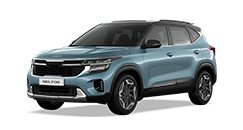
- Commercial Vehicle
- Find a Dealer
- Request a Brochure
- Request a Quote
- Request a Test Drive
- Service Center
- Service Policy
- Book a Service
- Our Movement
- Our Inspiration
- Sponsorship
- Sustainability
- Local Company
- Investor Relations
- Discover Kia >
- How does cruise control work?
“Connected to the accelerator, cruise control uses an actuator to control the throttle to maintain the pre-set speed. Adaptive cruise control is an enhanced system that manages the speed electronically.”
How Cruise Control Works
While driving on an open road for a long time, it would be pretty tiring to keep pressing the accelerator pedal. Cruise control is a feature that helps reduce such fatigue drivers would feel while driving a long distance. The system imitates the way human drivers drive. But instead of pressing the accelerator pedal, it uses an actuator to control the throttle and helps your car continue cruising at the same speed.
The cruise control system used in older cars is connected to the accelerator through a cable to maintain the gas pedal in a certain position to keep the pre-set speed. Whereas the system in newer cars electronically manages the speed through a program without a cable. Instead, a computer connected with various sensors and throttle controls operates the feature through a wireless system. This newer technology can automatically adjust the speed based on how fast the vehicle ahead is going while maintaining a safe distance. It dramatically reduces drivers’ fatigue since drivers do not have to press and release the accelerator pedal repeatedly. Drivers will find the system particularly useful on highways or roads with traffic jams during rush hour.
Cruise Control vs. Adaptive Cruise Control
Adaptive cruise control is an advanced version of the existing cruise control system. With the conventional system, the vehicle cruises at the speed previously set by the driver without the need to keep pressing the accelerator pedal. On the other hand, the adaptive cruise control system does the same; however, it can also calculate the speed of the car ahead of you by using the data from radar sensors and automatically adjust the speed of your vehicle to keep a safe following distance between the vehicles. If the vehicle ahead slows down, the system detects the reduction of speed and operates the controls to decelerate your car. If the car in front of you changes to another lane, the system gives the engine a signal to accelerate and reach the initially set speed.

- Shopping tools
- Discover Kia
- 2023 Seltos
- 2023-sportage

- SourcePWR PLUS ® Power Supply
- Universal and Custom Cruise Control
- Vehicle Speed Limiters
- Hands-Free Bluetooth ® Systems
- Vehicle Camera Systems
- Digital Video Recording Systems
- Parking Assistance and Blind Spot Detection
- Vehicle Seating Upgrades
Find and order a Rostra camera system with our all-new Vision Cross-Reference Tool by clicking here .
- Don't see your vehicle listed here?
- Please send us a message by clicking here and we'll be happy to assist.
Vehicle Search
- Add-On Cruise Control Systems
How Does Electronic Cruise Control Work?
Rostra is the world leader in the design and development of add-on cruise control systems for vehicles equipped with an Electronic Throttle Control - commonly referred to as "drive-by-wire." Our leadership status in the aftermarket cruise control product category is the byproduct of decades of research and development in vehicle testing and software architecture with a focus on passenger vehicles.
Add-on cruise control units for vehicles that are equipped with an Electronic Throttle Control System control the speed of the vehicle through the use of Rostra's custom E-Cruise Module , matched-fit accelerator pedal t-harnesses for a wide variety of vehicles, Onboard Diagnostic (OBD) port interface harnesses, and control switches designed to seamlessly blend into the steering column and dashboard environment.
The E-Cruise Module is the proverbial "brain" of the entire system and with the assistance of the included accelerator pedal interface harness, intercepts the communication between the pedal position sensor and the vehicle' Electronic Control Unit (ECU). Through the use of the included OBD port connector, the E-Cruise Module constantly monitors vehicle speed and loading and instructs the ECU to open or close the electronic throttle actuator to hold a set speed. Once the cruise control functionality is cancelled either by using the Off/Cancel button of the included control switch, depressing the brake pedal or depressing the clutch pedal (for manual transmissions), the E-Cruise Module returns full communication to the accelerator pedal leaving the driver completely in control of manual speed adjustments.
Electronic Cruise Control Layout
Below is a diagram that depicts a typical layout of an electronic cruise control system including the E-Cruise Module , accelerator pedal harness tie-in, OBD II port connector, control switch, and universal clutch disengagement switch (for some M/T vehicles).
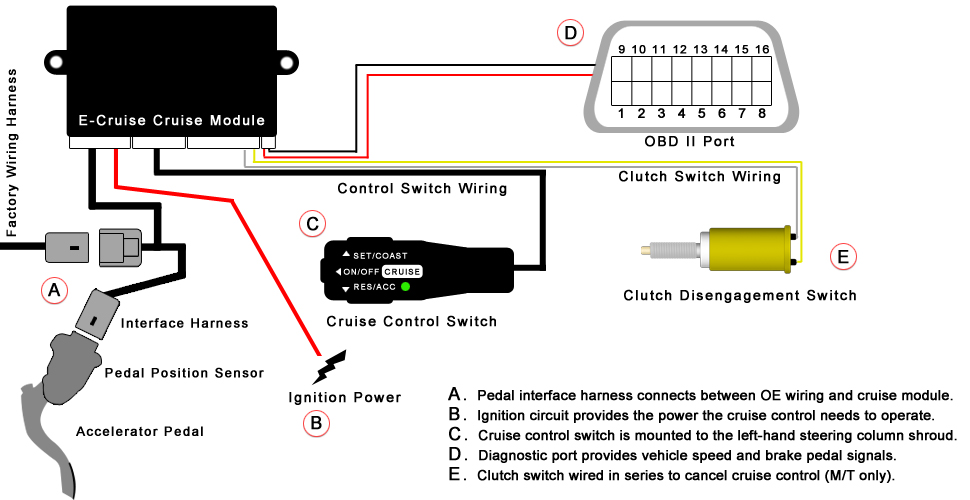
Product Development
At Rostra, when we develop an electronic cruise control system, we only design platform-specific applications and only offer vehicle-specific installation kits. While this does result in a multitude of available part numbers, in order to control highway driving speed, cruise control software must issue commands to a vehicle's onboard computer that are unique to each platform via the CAN bus system. Bits of information sent over this network of computers and micro-controllers must contain specific identifying information that cannot be safely created and/or transmitted by so-called "universal" electronic cruise control systems. An extensive effort goes into the design of every Rostra cruise control and includes the following steps:
1. We begin cruise control development by recording data from the vehicle's CAN bus using special software to determine which signals need to be sent to the ECU to control speed.
2. We then need to determine which E-Cruise Module best suites a particular application based on the signal that we need to send to the ECU when cruise control is active.
3. Once a vehicle-specific software package has been created, it is then written to the E-Cruise Module inside of a Faraday cage in order to reduce incidences of outside EMI.
4. Once the loaded software package has been verified in triplicate, we then test drive the vehicle to confirm that cruising speed holds between 31 and 80 MPH with minimal fluctuation.
5. When the cruise control has been determined to be operational within a strict set of parameters, it receives its sign-off from our staff and the control switch is permanently installed.
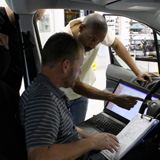
Click image to enlarge...
Q: How long does it take to create a cruise control system for a specific application?
A: The timing of our cruise control development is generally dependent upon the availability of vehicles for testing in our local market. Normally a new cruise control system takes approximately 4 weeks to deliver after initial testing, creation of our installation instructions, software verification, and final validation on multiple trim levels of the same vehicle model.
Q: Why should I buy an official Rostra cruise control system?
A: At Rostra, the quality control built into our manufacturing processes is a great source of pride for us as a company. Our headquarters in North Carolina is an ISO 9001 certified and TS 16949 compliant manufacturing plant that submits to yearly quality control audits and implements changes based on audit findings. We add innovations to our manufacturing procedures at every chance we get in order to deliver a product on time that is free of defects. Because of this, we are so confident in our products that we offer a 3-year/36,000 mile guarantee.
Q: Are Rostra's cruise control systems developed with DIY-type customers in mind?
A: Due to the sensitive nature of low-voltage vehicle electronics, we always recommend a professional or experienced installer perform the installation of a cruise control system. Many of our installation kits include plug-and-play harnesses, but still require locating a low resistance chassis ground and true 12-volt ignition source for operation. The connections are required to be soldered for secure fitment. Connections that are not soldered can seriously damage the onboard computer.
Q: Why should I not attempt the install of a "universal" electronic cruise control system?
A: To begin with, most "universal" electronic cruise control systems are of suspect origin. Generally these come from obscure overseas suppliers with little to no regard for quality control in manufacturing, and are never actually validated for proper operation on vehicles in the domestic market. Likewise, due to variations in emission control systems and requirements from one country to another, these "universal" systems do not include the requisite software that allows them to properly "talk" to your vehicle's computer. Commands issued to the network from these systems typically flood the onboard computer with malformed data which results in what is known as a "packet collision", or a condition in which the information sent over the network confuses the original equipment computer. This can have the effect of decreasing your gas mileage - the exact opposite of what a cruise control should do - and can even causes delays in vehicle emergency systems.
Q: How should I go about selecting a cruise control manufacturing supplier?
A: The short answer - question everything. Has the company been manufacturing cruise control systems for vehicles equipped with Electronic Throttle Control systems for many, many years? Does the company design every piece of the installation kit including accelerator pedal harnesses, control modules, control switches, and software themselves? Are their items manufactured and tested on vehicles in the United States before sale, or are they purchased in bulk from overseas and distributed wantonly? Do they employ multiple hardware and software engineers to develop these systems? Is technical support provided by the individuals that actually designed the cruise control you purchased? When you call them, can they detail the ways in which the cruise control system interacts with your specific CAN bus system? Do they maintain a quality audited manufacturing plant, or are they precariously assembling these items in their home's garage?
Q: What happens if I am installing a cruise control system and cannot get it to function?
A: We are pleased to offer technical support to anyone who has purchased our products. Our Technical Services department is available Monday-Friday from 8:00 a.m. to 6:30 p.m. EST to assist. Please note that we do require callers to register for a Technician Identification Number (TIN) before being connected to a representative. Click here to register for your TIN number now! Also, please keep in mind that we have a growing library of installation videos available on our YouTube channel that show in great detail the various steps taken to install a cruise control system.
Q: Where can I find a complete listing of the cruise control system Rostra manufactures?
A: At the top of this webpage, our Vehicle Search will allow you to view the products for a specific car based on its year of manufacture, make, and model. Likewise, you can visit our Global cruise universal cruise control page, our drive-by-wire cruise control page, our custom pedal interface cruise control page, or our custom pedal bypass cruise control page. As always, a listing of our latest cruise control systems is available as a PDF download via our Quick Reference Guide .
Rostra Cruise Control Features
- Improved Operation
- Coast/Reduce Speed
- Resume/ Accel
- Tap-Up, 1 MPH per tap
- Tap-Down, 1 MPH per tap
- Controlled Resume Rate
- Closer, More Accurate Control of Set Speed
- Easier Installation
- All-electronic operation
- Discrete control module
- Custom control switch
- Removable Wiring Harness with Locking Device
- Includes clutch switch wiring
- Automatically acquiresVSS (Vehicle Speed Sensor)
- Self Diagnostic
General Installation Kit Contents (Part Number 250-9507 Pictured)
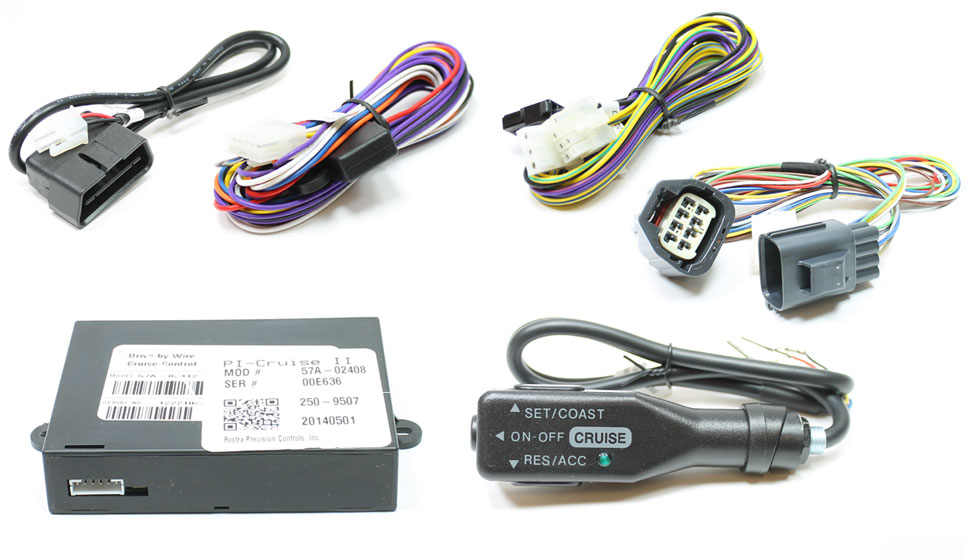
Cruise Control Installation Video (Part Number 250-9507)
For safety's sake, please remember that a universal electronic cruise control systems cannot provide the same level of safety and convenience that a custom-designed cruise control system can.
Rostra is a leading manufacturer of automotive comfort, safety, and convenience accessories including electronic cruise control systems, vehicle speed limiters, backup camera relocation kits, LED lighting, exterior vehicle camera systems, automotive lumbar supports and seat heaters, driver alert systems, and more.
Rostra: 2351 J. Lawson Blvd. Orlando, FL, 32824
WHAT OUR CUSTOMERS SAY
" Just what I needed for my 1962 Thunderbird! Before installing this, I would get leg cramps holding the throttle constant while cruising, I swear the throttle return spring was originally a bed spring. Installed this beauty before taking my trip down RT 66 in 2015. Finally, 7500 miles in comfort! "
Jim H. - United States
250-1223 Universal Electronic Cruise Control
" This is great. It installed pretty easily. I put it on my F-350 so I can park easier since my front camera is obstructed my LED lights and a light bar. I easily installed the sensors in the air dam below the bumper. "
Schawn D. - United States
Forward-Facing Parking Sensor System
" This installed very easily. I highly recommend it for anyone who needs this feature to make their car seat more comfortable. But this does require a high level of car handy skills, as you need to significantly disassemble a car seat. "
Sam G. - United States
Universal Lumbar Support System
" I installed this in a 2018 RZR RS one. I ride in the winter and have only a windshield. I installed the seat heater and it keeps me very warm. "
Ron B. - United States
Universal Seat Heater
" Once installed, the Jeep is more noticeable as one would expect. This is a very good safety upgrade--I was surprised DRL's were not standard on Wranglers. I have had compliments from other Wrangler owners. "
Chessie T. - United States
Jeep Wrangler LED Fender DRL
Be the first to know about special promotions and product updates. Enter your email and subscribe to our newsletter.
© 2024 Rostra Accessories
- Vision Cross-Reference
- Privacy Policy
- About Rostra

IMAGES
VIDEO
COMMENTS
The cruise control system controls the speed of your car the same way you do -- by adjusting the throttle position.But cruise control actuates the throttle valve by a cable connected to an actuator, instead of by pressing a pedal.The throttle valve controls the power and speed of the engine by limiting how much air the engine takes in (see How Fuel Injection Systems Work for more details).
Cruise-control is a feature found in some vehicles that allows the driver to maintain a constant speed without needing to keep their foot on the accelerator. The onboard computer controls the vehicle's speed. Additionally, most cruise control systems allow you to adjust your speed using buttons.
You press a button in your car to activate cruise control, and the ECU powers the pump in just the right amount to put the right tension on the cable. Lo and behold your car drives without your foot on the gas pedal! The ECU also takes info from the speed sensor to see if the current speed and the target speed match.
Cruise control is a feature allowing the driver to set a predetermined speed, which the system's computer maintains until the driver adjusts the speed, taps the brake, or disengages the system ...
Cruise control (also known as speed control, cruise command, autocruise, or tempomat) is a system that automatically controls the speed of an automobile. The system is a servomechanism that takes over the car's throttle to maintain a steady speed set by the driver.
Cruise control, in a general sense, aims to be as efficient as possible within the parameters the driver provides, which can potentially translate to less fuel being used over time. This is only ...
The cruise control system controls the speed of your car the same way you do - by adjusting the throttle (accelerator) position. However, cruise control engages the throttle valve by a cable connected to an actuator, rather than by pressing a pedal. The throttle valve controls the power and speed of the engine by limiting how much air it ...
Cruise control: Reduces fuel consumption, saving you extra fuel costs. Maintains a smooth, constant speed that helps eliminate motion sickness. Allows you to focus on the road more as checking your speed isn't required as frequently. Avoids speeding tickets when the cruise is set to maintain the speed limit.
Cruise control systems monitor current acceleration, reacting to changes in speed. This includes both speeding up and slowing down. Here's an example. If you begin going down a large hill, the cruise control system will adjust accordingly, reducing the throttle position to maintain speed. In this way, the cruise control system prevents your ...
You operate cruise control by either a stalk on the steering column or several buttons on the steering wheel. These include an on-off switch; a "set" button to select the speed you want the car to ...
Cruise control systems typically work by adjusting your car's throttle, which moderates the air going to the engine. In older cars, this was done with a system of physical cables connected to the throttle valve, but newer cars have electronic systems that can adjust the car's speed with an even higher degree of precision. A system of ...
Cruise control technology plays a vital role in the development of autonomous vehicles, or self-driving cars. In autonomous vehicles, cruise control systems work together with other advanced driver assistance systems (ADAS) to enable the vehicle to operate without direct driver input.
How does cruise control work? Modern cruise control systems are integrated into a car's electronics, and are often combined with additional tech, such as lane departure warning and blind spot sensors.
Set the cruise control: Once you've switched the system on, press the set button. This will communicate with your car to hold the current speed. In most vehicles, this will turn the dashboard indicator green. After the cruise control is set, you can remove your foot from the accelerator and the car should maintain its speed. 4.
For your car, check the manufacturer's manual for the location and specific instructions. To set cruise control, press the ON/OFF button or switch. If you press this button again, it typically turns the system off. The Res + (resume / increase seed) button increases the cruising speed by 1 mph, while the Set - (set speed / reduce speed ...
Simple to use, all you need to do is turn on the system in your vehicle, reach your desired cruising speed, and set it. The system then assumes control of the accelerator, maintaining the set ...
Cruise control work with a manual transmission just the same way it does with an automatic. ... More advanced adaptive cruise control systems use camera or radar-based sensing to determine the ...
Adaptive cruise control as of 2013 ranges from $2,500 at the high end to as little as $500. Less costly "partial ACC" only works at speeds of 20 or 25 mph and up, but it's markedly cheaper.
Cruise control in a car replicates the inputs of a driver to control the vehicle's speed. But instead of pressing the accelerator pedal, it uses a different mechanism to maintain a constant cruising speed. Initially, the system used a cable to control the accelerator (throttle valve). You can find these mechanisms in older cars.
Just press the gas pedal to bring your car up to the new speed, and hit the "SET" button again. This will set cruise control at the new speed. If your car has a +/- button for cruise control, press this when you want to raise or lower your car's speed. Part 2.
The cruise control system used in older cars is connected to the accelerator through a cable to maintain the gas pedal in a certain position to keep the pre-set speed. Whereas the system in newer cars electronically manages the speed through a program without a cable. Instead, a computer connected with various sensors and throttle controls ...
We begin cruise control development by recording data from the vehicle's CAN bus using special software to determine which signals need to be sent to the ECU to control speed. 2. We then need to determine which E-Cruise Module best suites a particular application based on the signal that we need to send to the ECU when cruise control is active. 3.
1. To turn the feature on, press the cruise control On/Off button on the steering wheel. Your vehicle will default to the type of cruise control you last used when you turned your vehicle off. When the system is turned on, you'll see a white Adaptive Cruise Control icon in your cluster display or on your Head-Up Display, if your vehicle has ...
Chrysler is recalling 26,776 model year 2024 Pacificas and Voyagers.. The traction control system (TCS) does not function when cruise control is activated, increasing the risk of a crash. What to ...